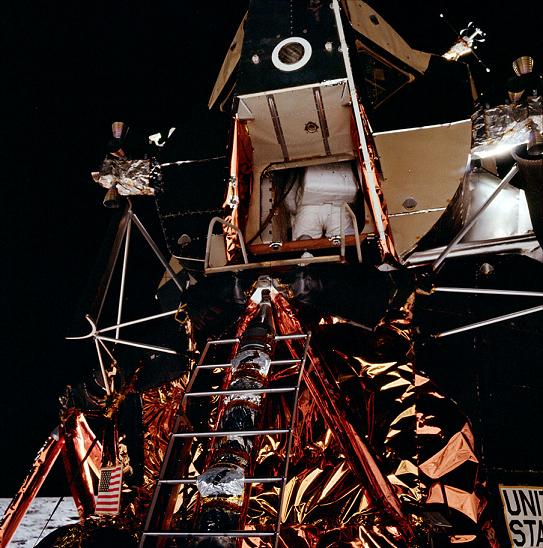 On a series of six photos beginning with this photo (AS11-40-5862) |
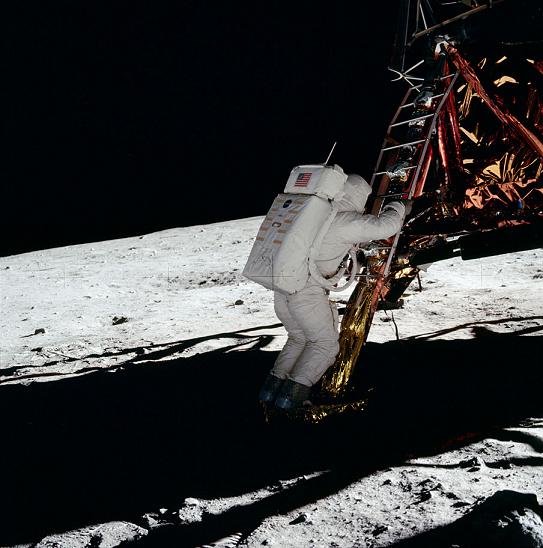 and ending with this photo (AS11-40-5869) |
 We can see Buzz going down the ladder. There is a first thing which looks strange: The articulation of the ladder looks unnatural. |
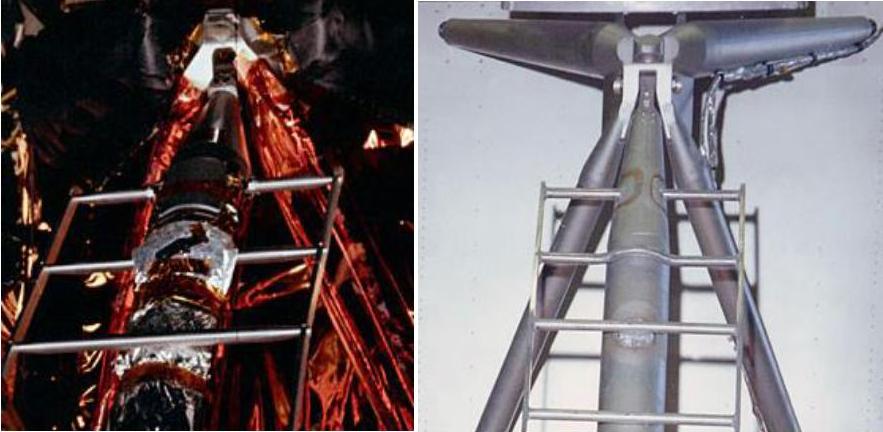 If we compare with the normal articulation of the ladder... |
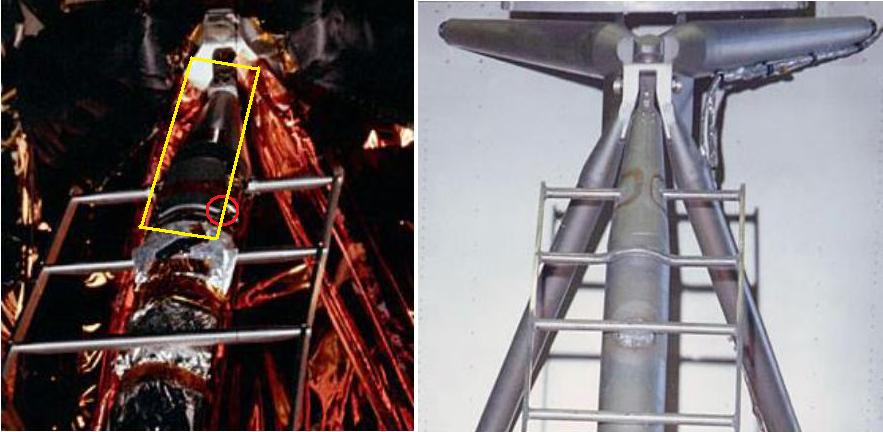 ...we notice that there is an alien object which has been superposed to the articulation, and this alien object is...a bottle! |
 On this photo (AS11-40-5962), we can see the astronaut getting out of the hatch. He is still in the hatch. The size of this hatch is 32 inches square; David Percy and Ralph René claim that it was not possible for the astronauts to go through this hatch with their backpack. Clavius asserts that it was possible, that it was just a question of practice. But even Clavius has to admit that the astronauts had to crawl to go through this hatch.  But, when we look at the astronaut in the hatch closer, we can see that he is not actually crawling... HE IS KNEELING!!! This is totally impossible, the astronaut could not stand on his knees in the hatch, this is pure fantasy!!! 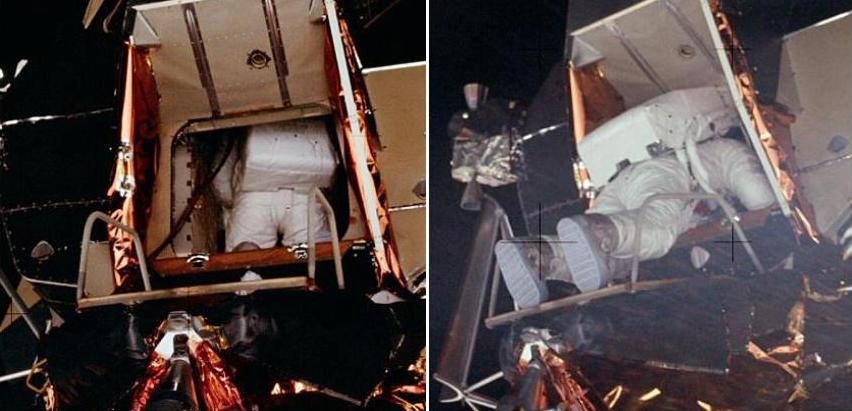 This double view compares the astronaut of the photo AS11-40-5962 with the astronaut of the photo AS11-40-5963; compare the astronaut with the opening of the LM on the two photos... The astronaut of the second photo is considerably bigger than the astronaut of the first photo. The astronaut of the second photo is too big to go through the hatch, even if he crawls (and still less if he kneels). It is obvious that the astronaut of the first photo is just a reduced model, a toy! Now, if we compare the photo of Buzz descending the ladder with the video of Armstrong first descending it, doesn't something strike you? On the video, though the background is not less luminous than on the photo, the astronaut and the ladder appear much darker, less luminous! Why? Did someone switch on a light when Buzz Aldrin descended the ladder? |
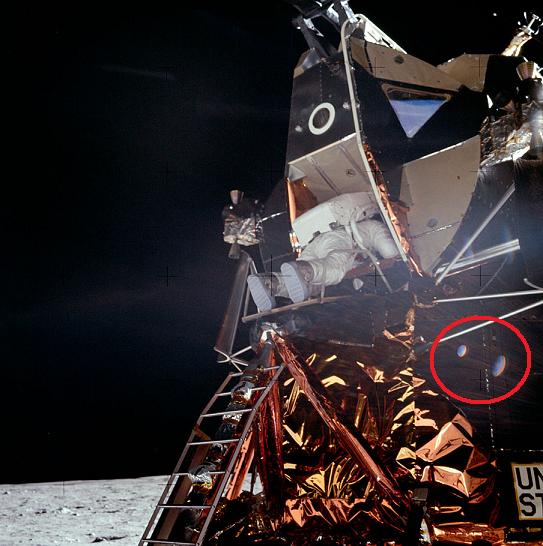 On the photo AS11-40-5863, we can see lens flares I have circled. The lens flares are normally oriented in the direction of the sun. According to them, the sun would be on the left of the photo, but we know it is not; we know the sun is on the right of the photo, since the lem's shadow is on the left. |
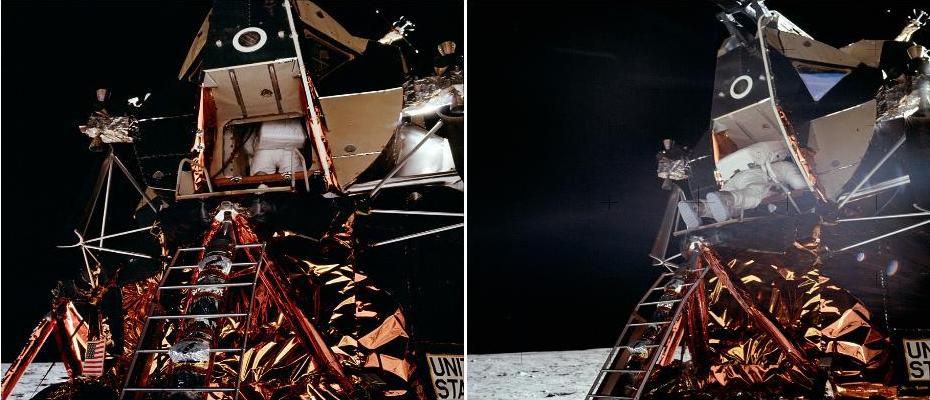 If we compare the two photos AS11-40-5862 and AS11-40-5863, we notice something abnormal. 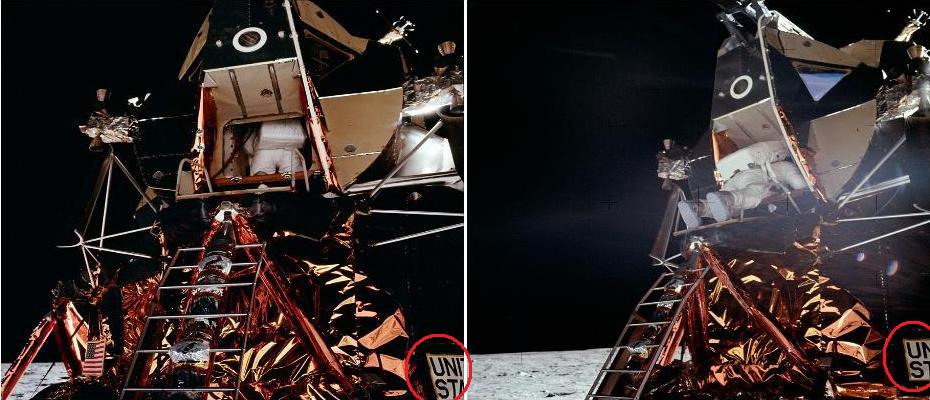 In the second photo, the photographer has obviously turned counterclockwise around the LEM (moved on the right), and has also moved a little farther away from the LEM; logically the US plate on the extreme right should have moved on the left, be a little smaller, and also have a different orientation. I have represented the lem seen from above with the two logical positions of the camera on the two photos:  The first position of the camera corresponds to the first photo in which the photographer is close to the ladder and facing it (or almost). The second position of the camera corresponds to the second photo in which the photographer is farther from the ladder and seeing it in oblique. 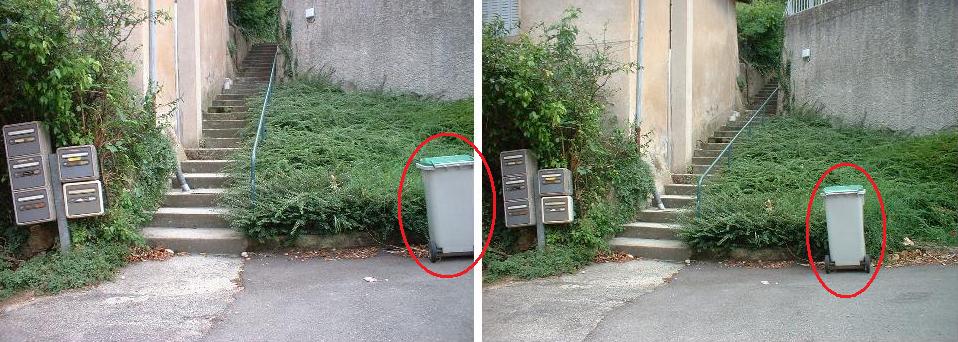 On this example taken outdoors, I have taken a first photograph of a flight of stairs with a trash can on the extreme right. Then I have moved on the right and a little backed up, like the photographer did between the photos AS11-40-5862 and AS11-40-5863, and taken a second photo: On the second photo we can see that the trash can has been pushed on the left, is a little smaller, and differently oriented. On photo AS11-40-5863, the US plate should also have been pushed on the left, and have a different size and orientation, what it doesn't! Note: The fact of using a trash can is not a lack of respect, but simply because the trash can was mounted on wheels and easy to move. An Apollo fan has contested that my photos were accurately representing the change of situation in the Apollo photos. In order to show that my demonstration is close to what we can see in the Apollo photos, I show where the limits of the first Apollo photo on the second Apollo photo are:  And also where the limits of my first photo on my second photo are: 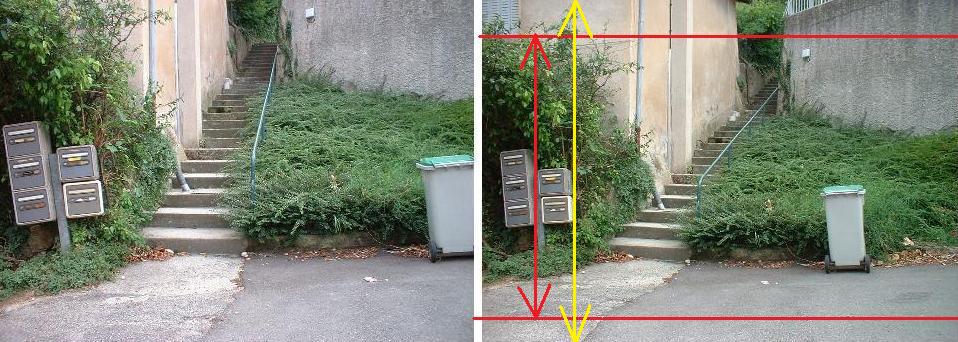 In both cases, the ratio between the visualized height of the first photo and the visualized height of the second photo is around 0.8 (0.80 for the Apollo photos, and 0.82 for my photos, which means that the change of perspective is even a little more important in the Apollo photos). My demonstration is thus not far from what we see on the Apollo photos, and well shows the problem with the incompatible positions, sizes and orientations of the US plate on the two photos. The Apollo fan has kept denying that my demonstration was proving that there was a problem with the Apollo photos, and kept asserting they were normal. In particular, he has said to me that my demonstration was invalid, because my trash can was not against a wall. I have told him that if the trash can had been against a wall, it would have changed nothing: 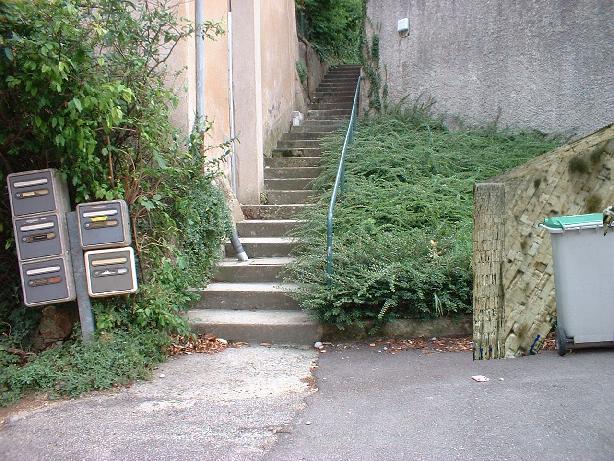 I asked him to show real photos proving what he was asserting. He finally triumphantly posted real photos, which were reproducing the situations of the Apollo photos according to him, and that I show below: 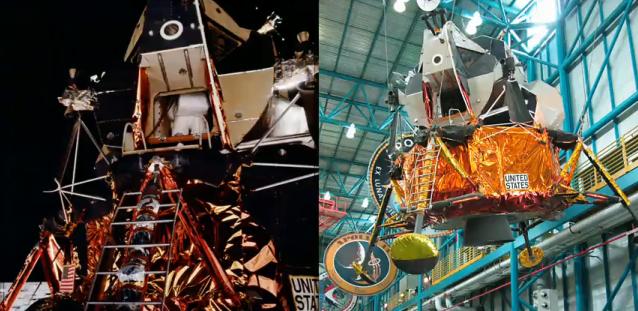 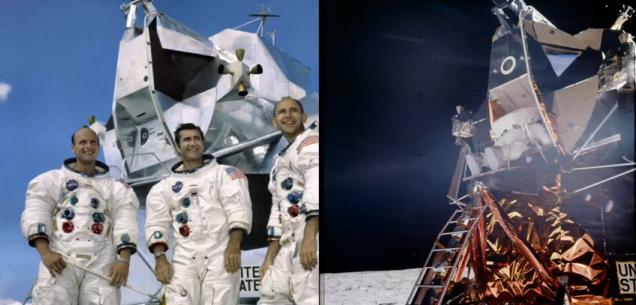 Then, I had no difficulty to prove him that these photos were different from the Apollo photos. Concerning the second photo (AS11-40-5863), if we draw a line along the edge of the Lem's exit, this line cuts differently the US plate on the Apollo photo and the real photo.  And in what concerns the first photo (AS11-40-5862), the difference is still more spectacular: One just has to count the rungs of the visible part of the ladder on the first Apollo photo to reconstitute this part of ladder on the real photo, and we can see that the ratio of the height of this ladder's part to the distance between the ladder and the US plate is very different between the Apollo photo and the real photo;  Now, if I take a window of his photo which contains the same number of rungs of the ladder as on the Apollo photo, and with the US plate at the extreme right, we can clearly see that it's much different: 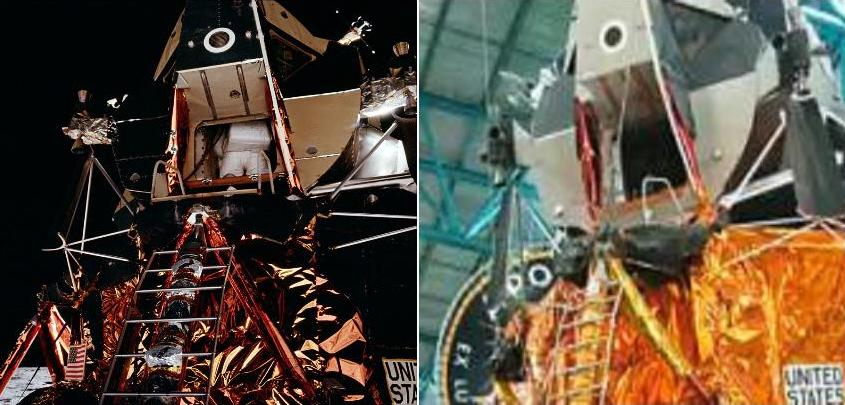 All the proportions are different. We can also notice some details which are different: 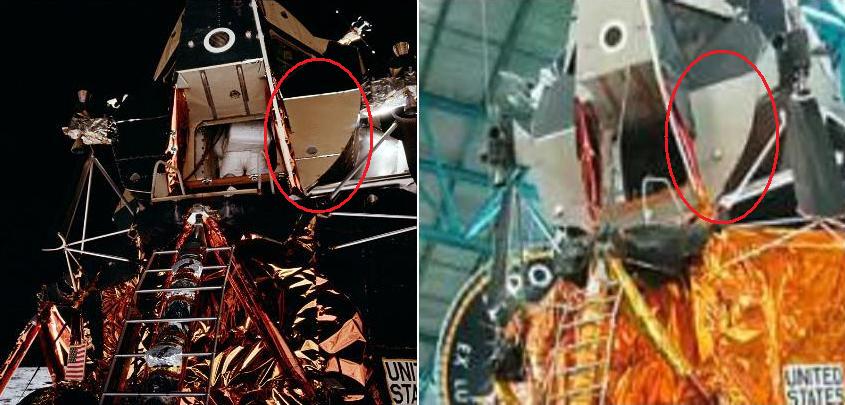 For instance, the device I have circled in red has obviously a different orientation on the two photos. If we look at the real photo of the lem, the edge which is on the left of the US plate shows no change of continuity 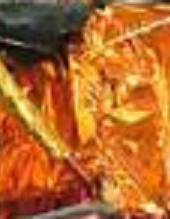 The right part is a little brighter, because the exposition to the light is a little different, but there is a continuity on the shape. The Apollo photo shows something very different:  There is a clear abnormal discontinuity on the edge, there is no connection between the two parts on each side of the edge. The color is also much different; the part on the right is duller than the part on the left, and yet the part on the left is more in the shadow than the part on the right. If it is the lunar reflectivity which lights the part on the left, why would it refuse to also light the part on the right, especially when this part is less in the shadow than the part on the left? The explanation is very simple; the part which is beyond the edge does not really belong to the original photo and has been pasted into it from another photo. Let's consider these two views I have taken of a house by moving along it:  I take the right wall (relatively to the camera) of the house of the view of the left and I paste it into the house of the view of the right; it gives this: 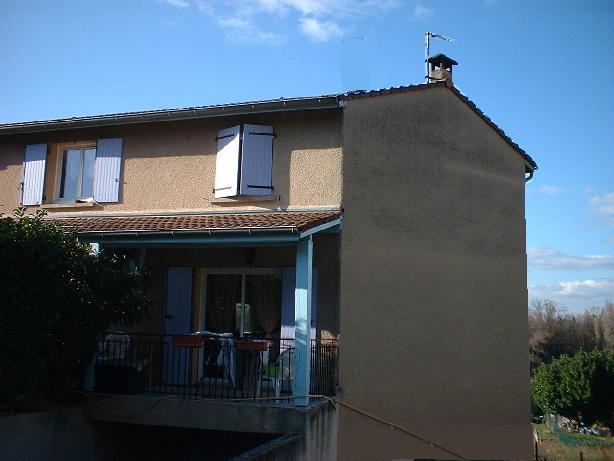 It makes a wrong house, with a wall on the right which has an incorrect orientation which does not belong to it, but if I had not told you I have modified the house this way, you could have found this photo normal! That's exactly what they have made on these photos:  The fakers have taken parts of other photos and pasted them into these photos; this way they can manage to have an US plate which has the same position, size, and orientation on the two photos, though they should be different on the two photos. Now I show you something which is still more strange.  This is a photo from Apollo 14: You can see that the US plate is not down on this photo, but up! So, between Apollo 11 and Apollo 14, NASA would have changed its mind, and decided to move the plate from down to up? |
 The second anomaly is that there is an object which is brightly luminous on the first photo, whereas there is a triangle shaped window which is dull, and on the second photo, it's the converse: the bright object suddenly becomes dull, and the triangle becomes luminous. It's not the lem which has moved, it's the astronaut. And between the two photos, we know there is a short time, since it's the sequence during which Buzz is getting out of the Lem. So, it's very unlikely that within this short time the lunar reflectivity (supposing it exists) could have changed that much. But, even supposing it would have changed that much in a so short time, there is still something abnormal: Before the grey luminous object of the first photo, there is a bar which comes across it. If this object is now in the shadow on the second photo, then this bar should also be in the shadow, and it is not, it is still luminous. And for this, there is absolutely no excuse! |
If we make an animation with these two photos, it makes a funny effect. |
 On the photo AS11-40-5862, we can see the engines of the RCS on the top right (I have circled them). 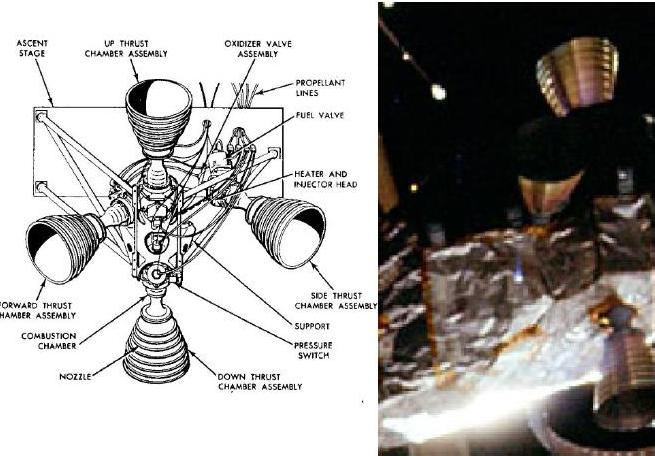 But the cones of the RCS are incorrectly positioned (on the left, their correct position as indicated in the LM's handbook). On this photo, the cones are disposed in an anarchic way, and are also of unequal size. |
 Between these two photos (AS11-40-5866 and AS11-40-5867), the whole scene has rotated clockwise (we can see that a foot of the LEM has passed on the other side of another foot); this is because the photographer has moved on the right (which creates a rotation of objects he sees; of course it is not a real rotation). |
 But we also see that the strut which is under the LEM has turned in the opposite direction (counterclockwise). |
 Why do we see it? By the way a white reflection has moved on the strut: The white reflection moved from the large section of the strut to its narrow section, which is the indication of a counterclockwise rotation. |
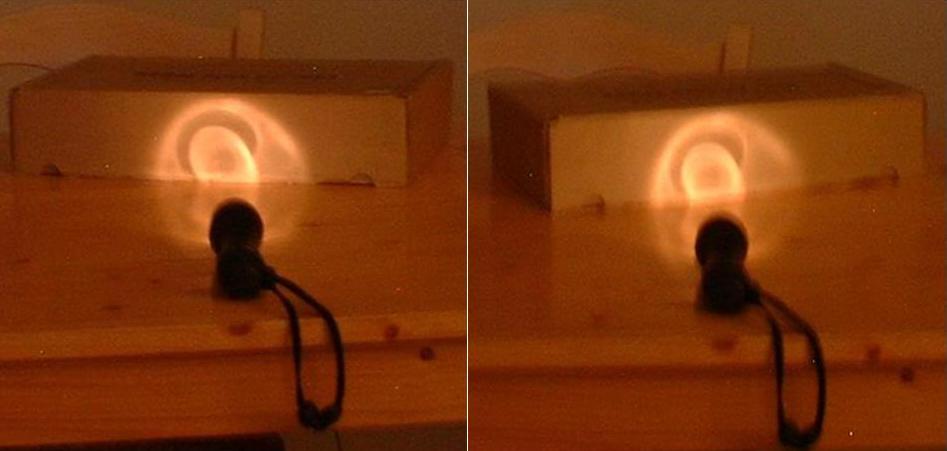 I here make you a little demonstration which shows how it is possible to deduce in which direction the strut turned from the move of the white reflection. In this demonstration I light a cardboard box with a box with a torchlight under two different angles. Between the two photos, I turned the box counterclockwise, and we can see that the reflection moves on the left, like the reflection did on the strut. Note: I didn't use the flash, because it tends to wash out the reflection. In fact, the white reflection should not have moved at all, for only the photographer has moved; the lunar reflectivity (supposing it really exists) has no reason to have changed between the two shots, and the lem has (normally) not moved. The white reflection should have stayed at the same location on the strut. |
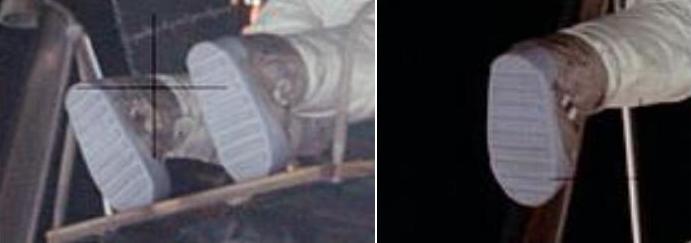 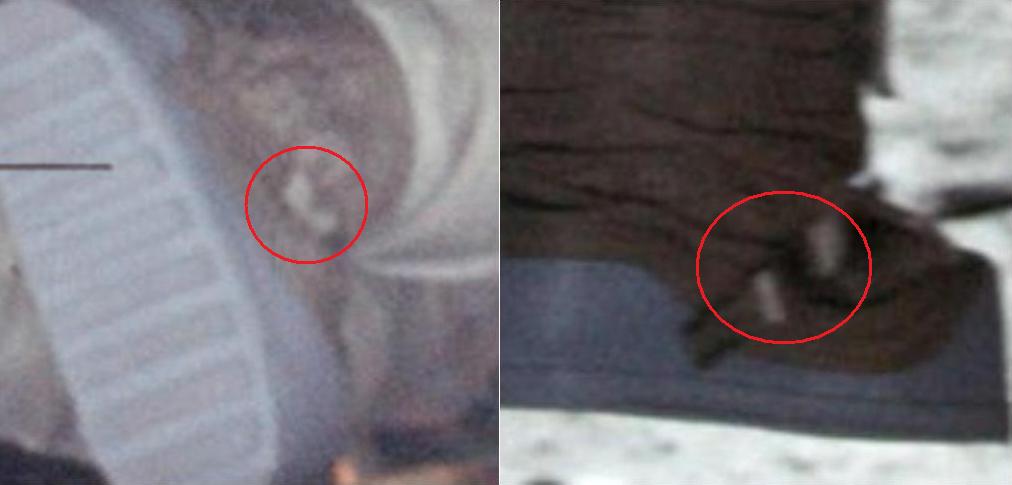 If we compare the buckle of the shoes between the photos AS11-40-5863 and AS11-40-5867, we can see it's different. |
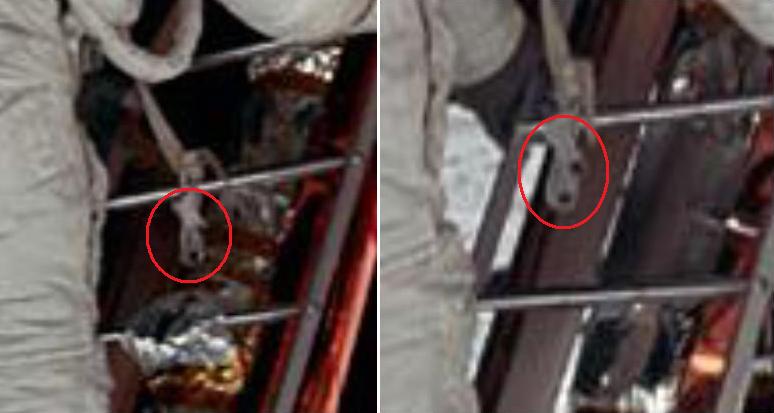 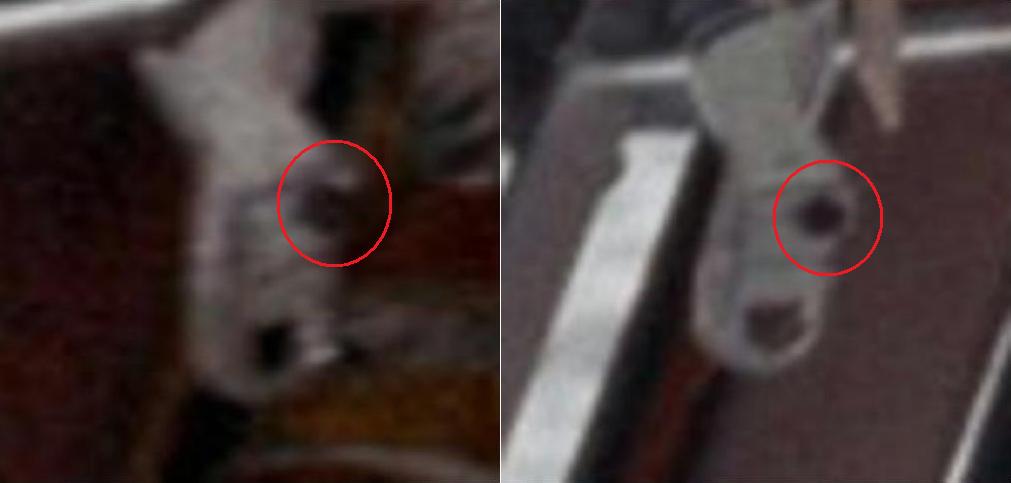 And if we compare the metallic piece at the end of his harness on photos AS11-40-5867 and AS11-40-5868, it obviously looks different. |
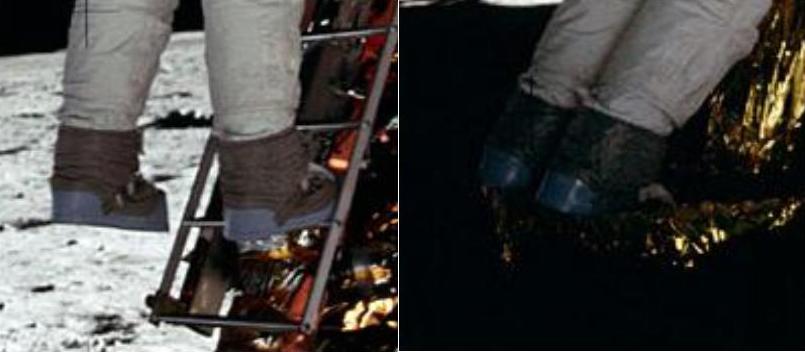 On the last photo of the sequence (AS11-40-6869), the shoes of the astronaut suddenly become dark blue (whereas they were light blue before). You are going to say that it's because they now are in the shadow; but then, why is there a shaft of light on them? |
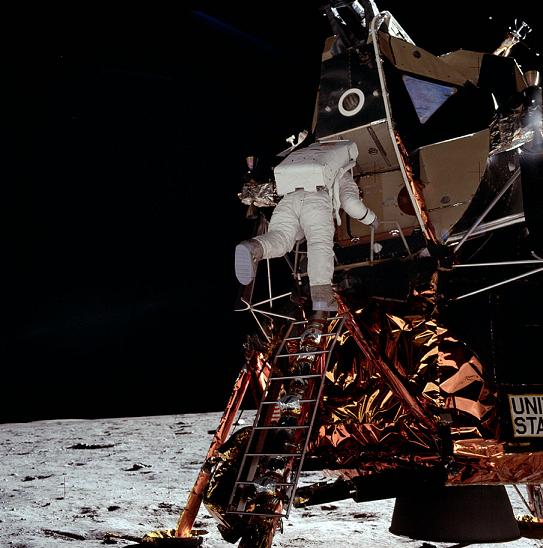 On this photo, there is something which is rather shocking: The astronaut has his two feet in the air: his left foot is floating whereas his right foot isn't still on the first rung of the ladder; it doesn't seem a normal way of going down a ladder, rather an acrobatic one! |
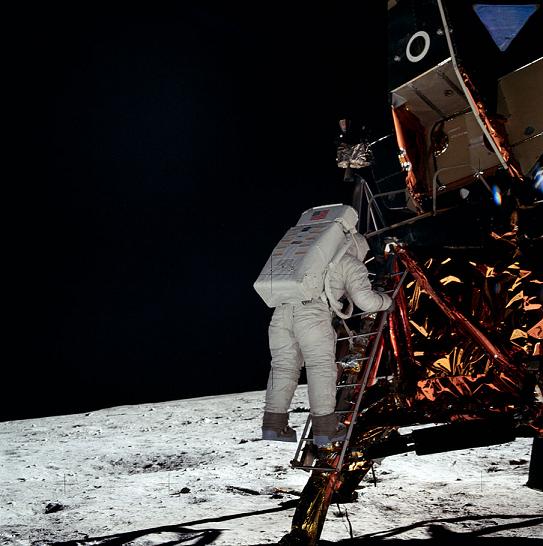 Logically, when he arrives on the eighth rung, he should put his left foot on this rung if he has alternated his two feet. But it's still his right foot he puts on this rung. |
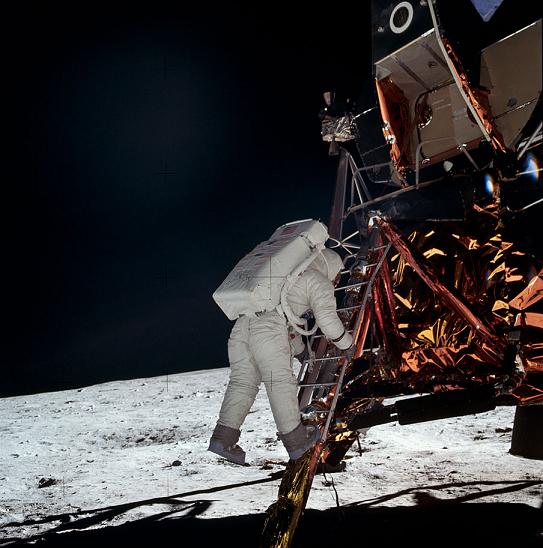 So, we tell ourselves that he may have missed a rung, but at least it's his left foot he will put on the last rung...not at all, it's still his right foot. |
So, we wonder he has not gone down the whole ladder with his right foot, |
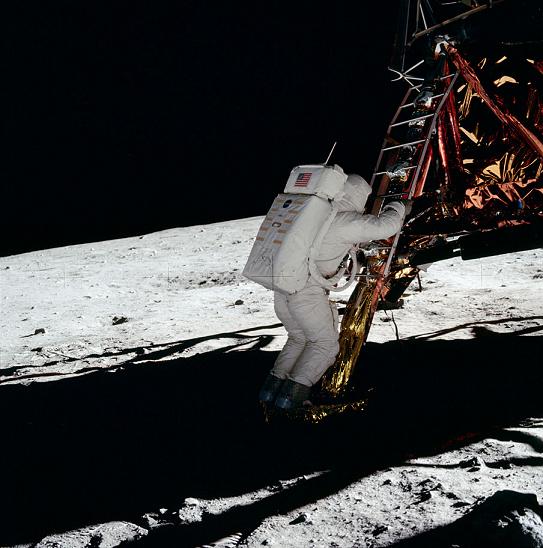 This is the photo AS11-40-5869 showing "Buzz" on the lunar ground after he descended the ladder. But in fact, he would never have this position after he jumped from the last rung of the ladder. Since the ladder is in oblique, he would have to get away from the ladder when he jumps from the last rung, otherwise he might bump into the ladder; his helmet might hit the ladder, and in that case it might break, with terrible consequences for the astronaut. We can also see that Buzz has his two feet on the footpad; he would never have his feet on the footpad in reality, for they would be in unstable position on it, and he might fall. 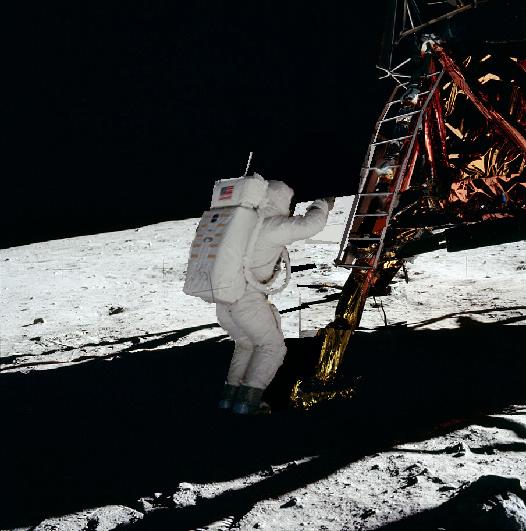 In fact, Buzz could rather have this attitude after he jumped from the ladder, it would be more logical (it's the same astronaut, but I moved him to a more adequate position). The animated descent of Buzz. On this same photo, we can also see that the last rung of the ladder is above the waist of Aldrin, quite high. But, if we compare with a demonstration on earth (right on the double view), the last rung is hardly over the knees of Armstrong. You are going to tell me that the model used for the demonstration might be a little different from the real lunar module (Someone has told me that the ladder was lower on the demonstration model in order to allow the astronaut to climb it more easily in earth gravity, but there is not a single photo of the training showing an astronaut climbing the ladder)? Then let's compare with a photo of Apollo 17 (right of the double view, referenced AS17-134-20482); the last rung of the ladder is also lower than the astronaut's waist, and he is not standing on the footpad. 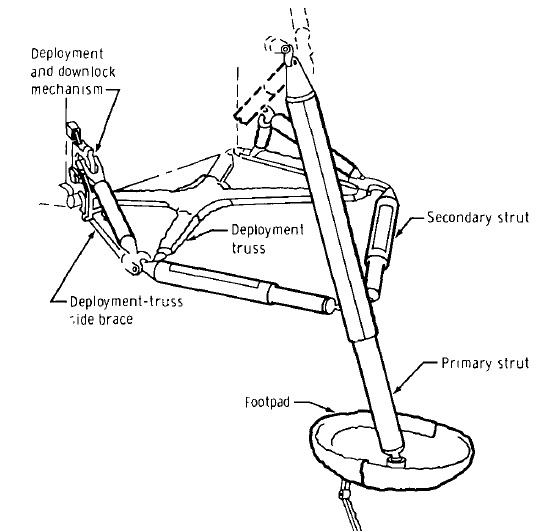 Then, Apollo believers have asserted that this apparent anomaly could be explained by the fact that the leg had been made shorter by the compression of the strut of the front leg, which made the ladder closer to the ground. 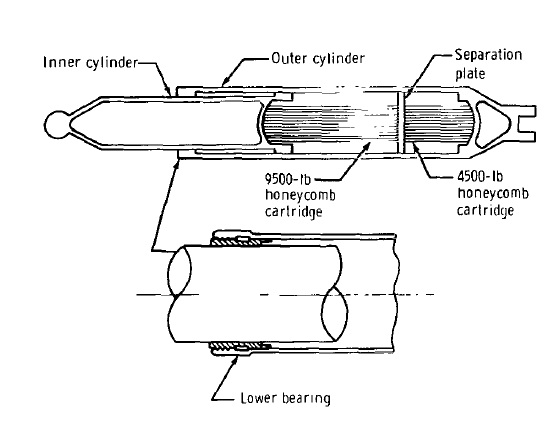 Indeed, inside the primary strut, there was a honeycomb aluminium cartridge which was able to absorb a relatively important shock by compression. 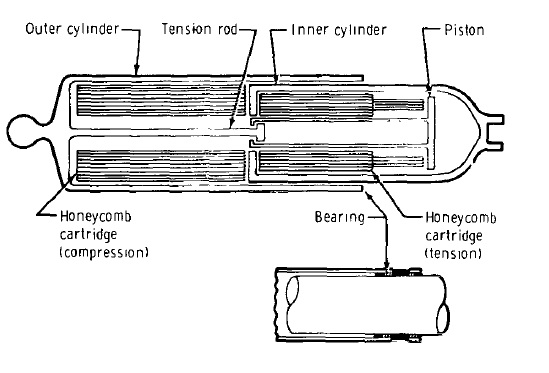 There also was one inside the secondary struts.  The Apollo believers justify the fact that there could be a consistent difference of height of the ladder by this phrase of the lander gear report: "Even though the primary strut is designed for a maximum 32-inch stroke, no primary strut stroking was recorded on Apollo 11." But the fact that the primary strut was theoretically designed for a maximum 32-inch stroke does not mean that the compression could go as far as 32 inches.  Besides there is a good reason that the stroke could not go as far as the full 32 inches, which is that the descent engine skirt does not allow it. 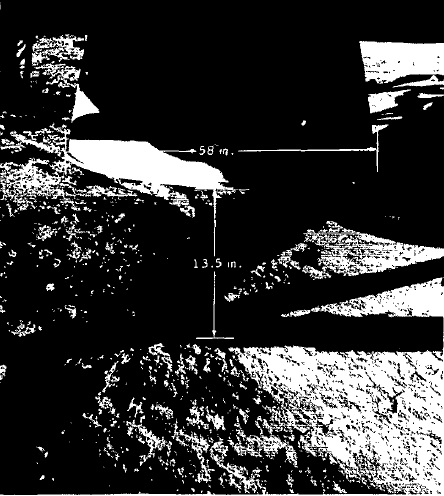 The descent engine skirt clearance is 19 inches on a perfectly flat ground; in fact, based on simulation, it was estimated that the clearance would be of 13.8 inches (13.5 inches measured by NASA on Apollo 11 photograph). This obviously limits the maximal admissible stroke to consistently less than the 32 inches (even though the legs are a little in oblique), for the maximum stroke length should still allow a minimal clearance for the descent engine skirt.  Besides, in the mission report of Apollo 17, we find this (page 10-12): "The rear strut may have stroked, but the other three did not." So, the strut with the ladder did not stroke according to this report. Therefore the last rung of the ladder had not reason to be closer to the ground on Apollo 17 than on Apollo 11. |
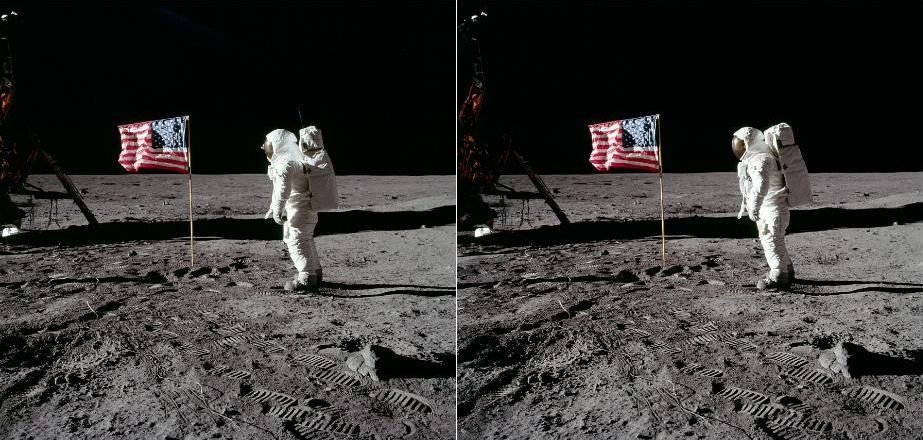 On these two photos (AS11-40-5874 and AS11-40-5875), we can see Buzz saluting the American flag. |
A first remark is about the strange shape of the shadow of Buzz. 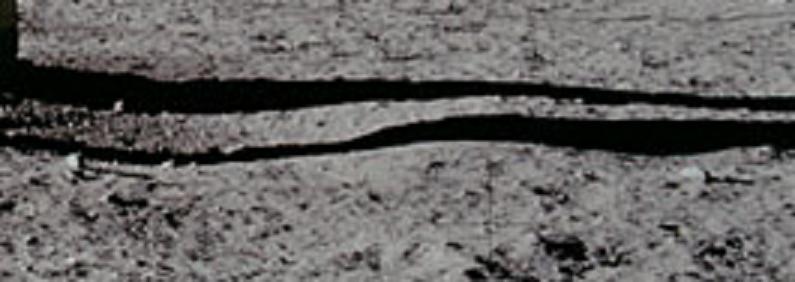 This shadow is strangely symmetrical; a very particular structure of the relief could eventually explain it, but it really would have to be very particular! |
 Now look: On the first photo, the backpack is partially lit on its side, and on the second photo, the astronaut has twisted his body, and the backpack is now entirely shadowed. This has a meaning: It means that, on the first photo, Buzz was not perfectly facing the sun, whereas, on the second photo, he is better facing it; the problem is that the direction of his shadow does not correspond with the second position of his body, but is closer to his first position instead. 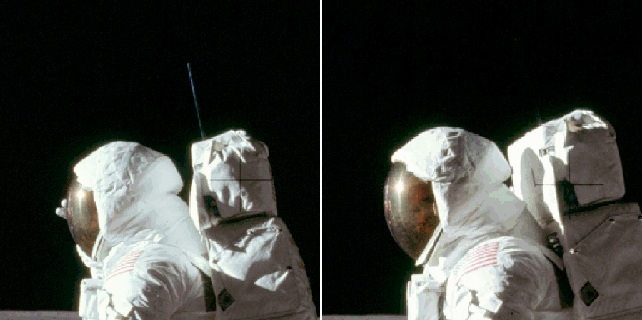 On AS11-40-5874 (left), we can see the antenna of the backpack, but, on AS11-40-5875 (right), we can't see it. Yet, these photos are taken at the same moment, and the antenna is exposed the same to the sun; the only difference is that it is slightly turned between the two photos, but it hardly explains it completely disappears. |
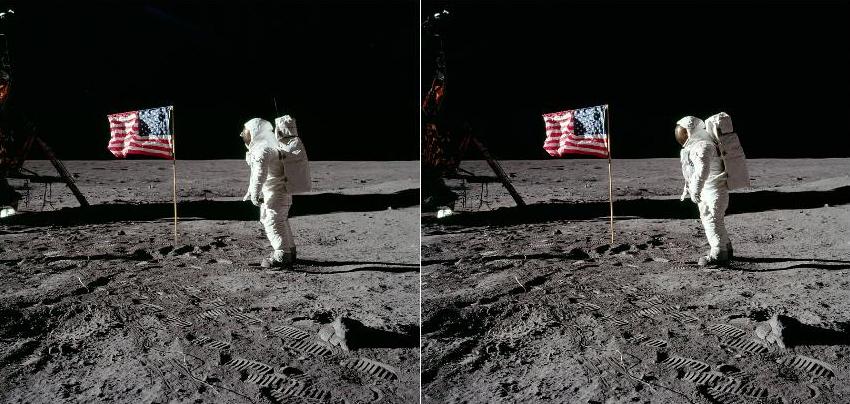 Between the photos AS11-40-5874 and AS11-40-5875, Buzz twists a little his body without moving his legs. If we make an animation with a close-up of Buzz, we can see that, if the shadow of his left leg does not move at all, such is not the case of the shadow of his right leg (although it is visible that his right leg does not move). |
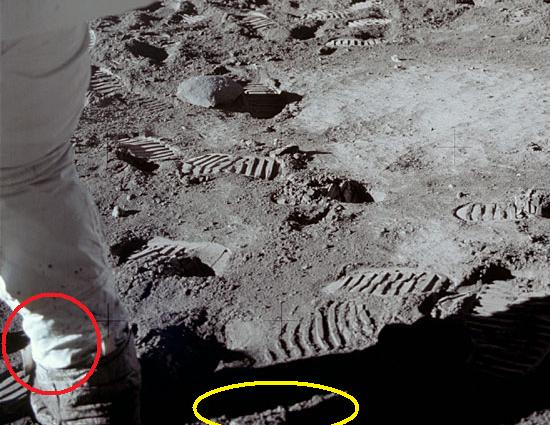 On the extreme left side of the photo AS11-40-5916, we can see the back of an astronaut. Given the direction of his shadow, we would expect the inner side of his right leg to be shadowed by the left leg, and we can see it is brightly lit. And we wouldn't expect to see a lit window on the middle of this shadow. |
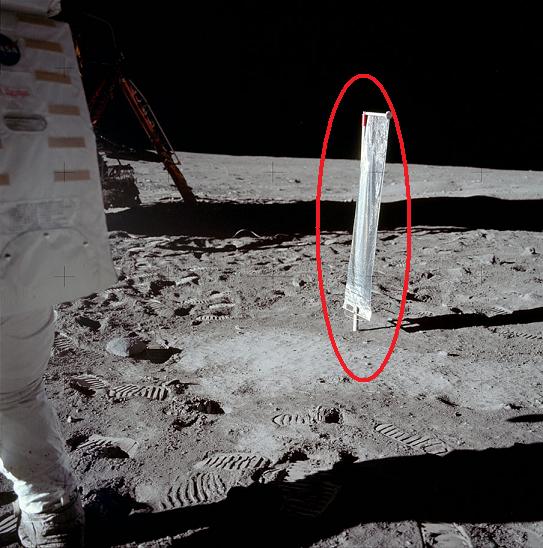 On the photo AS11-40-5916, we can see the solar wind collector (circled) and its shadow.  But, if we look closely at the bottom of the SWC's shadow, we can see two holes which appear abnormal: the longer hole's shadow should be the shorter one if we look at the SWC's bottom. |
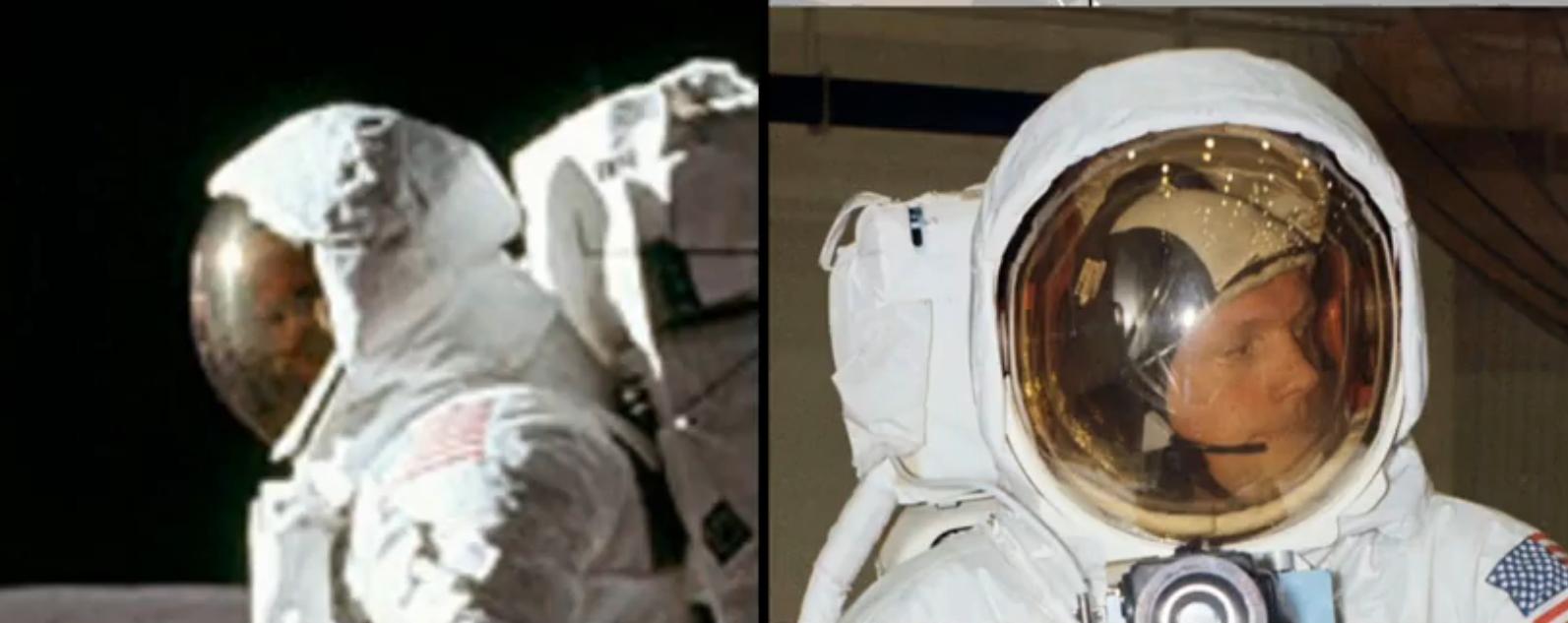 On photo AS11-40-5875, we can see a strange face inside the visor (left on the double view). If we compare with the face of an astronaut on earth, this face appears very differently: It appears smaller, and also incorrectly positioned. What's also weird is that, of all photos, this one is the only one which allows to see the face of the astronaut, in spite of the fact that it is fully exposed to the sun; all other visors reflect like a mirror, and don't let see what's behind the visor. |
 On these photos, the flag is obviously identical. |
 An Apollo fan has made a Gif on Wikipedia to show it was not moving: |
 The problem is that on this photo (AS11-40-5886), the flag which is seen on the other side doesn't look the way it should: The flag we see on this photo is not the exact other side of the flag that Buzz saluted. |
In fact, if we look at the flags closer:  we can see that the blue part with the stars is shaded on both sides: If it is shaded on one side, it logically shouldn't be on the other side. |
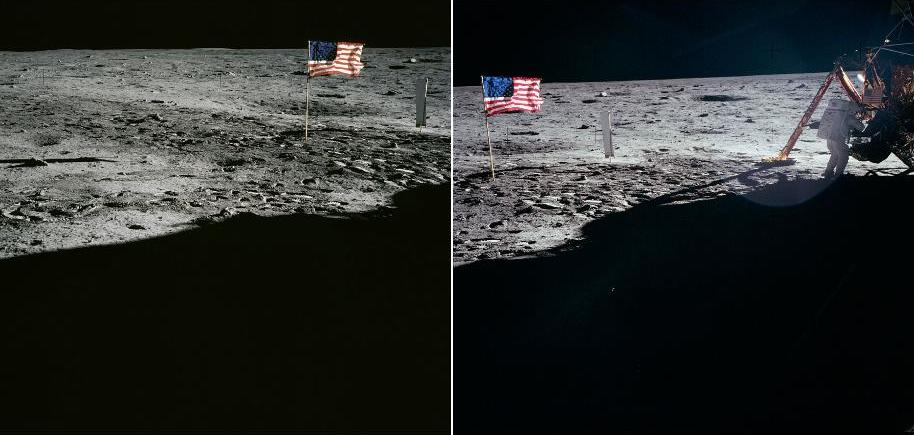 The photos AS11-40-5885 and AS11-40-5886 show two views of the lunar ground with the flag and the solar wind collector, and the LM's shadow in the foreground. Between the two photos, the photographer has just turned his camera clockwise, for the LM's shadow appears the same and is positioned the same way relatively to the flag and the solar wind collector. 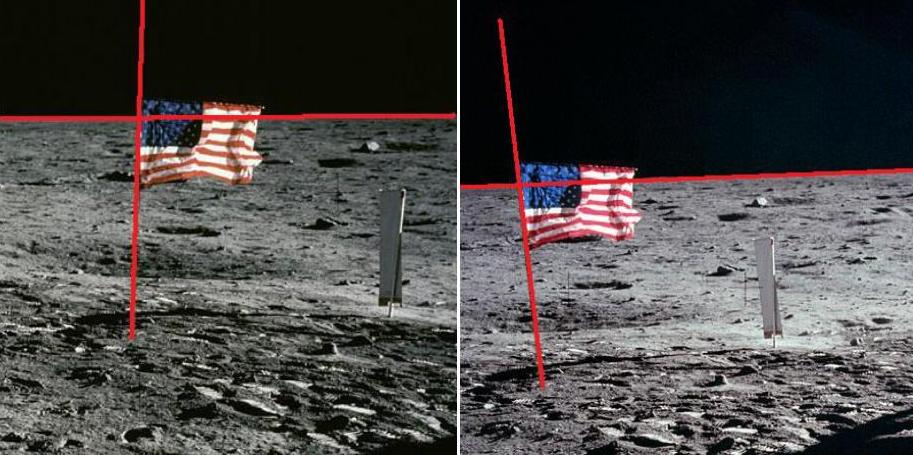 Normally the angle between the flag's pole and the horizon line should be the same on the two photos...but it is not at all the case, as you can see! |
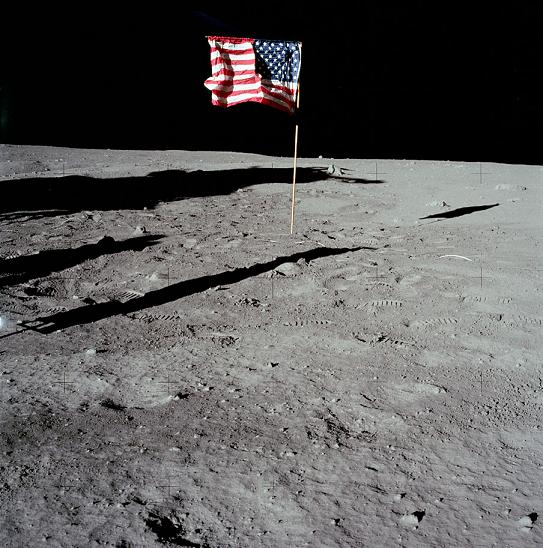 On this photo (AS11-40-5905), the shadow of the pole of the flag brutally stops, and is nowhere to be found till the foot of the flag. 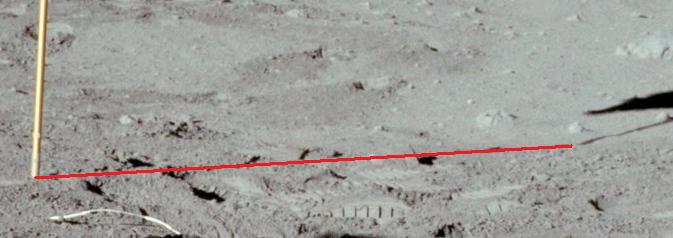 What’s strange is that, if we draw a line from the point where the pole’s shadow stops to the foot of the flag (Figure K.4), this line is not aligned with the visible part of the pole’s shadow whereas it should be! 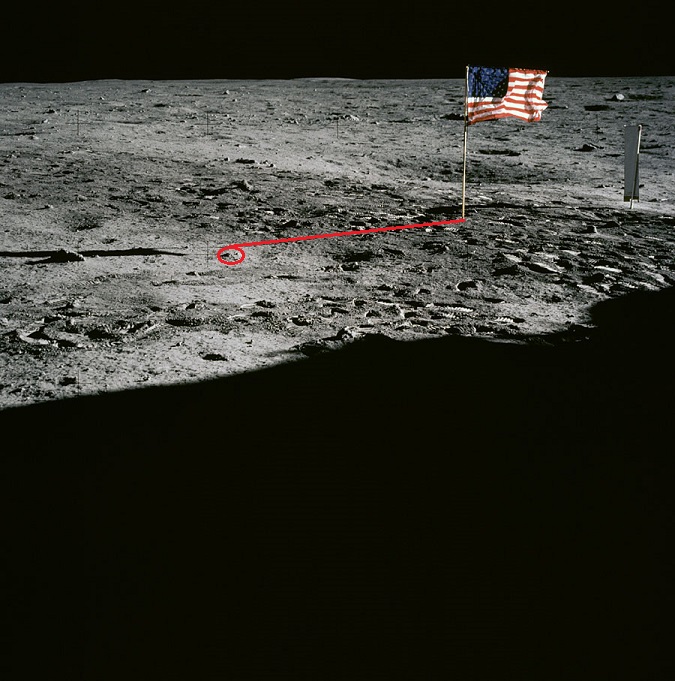 On this photo, AS11-40-5885, we well see the relief of the moon, and we can see the point where the flag's shadow reappears on the photo AS11-40-5905, for it is close to a stone I have circled, and, if we draw a line from the flag's foot to this point, the final part of the shadow's flag is oriented on the right relatively to this line, while it is oriented on the left on the photo AS11-40-5905. 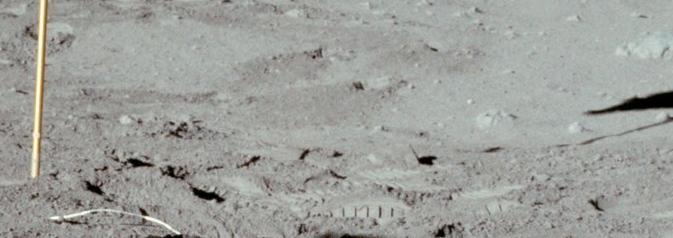 Between the foot of the flag and the place where the flagpole's shadow appears, we can see black spots, but it's only holes and cracks, not the shadow of the flagpole.  This close-up shows the area where the pole’s shadow is not visible, with a red line showing the logical location of this one (that is between the flag’s foot and the place from which it is visible again). The Apollo fans think that this shadow might be hidden by a broken relief, and that the black spots correspond to places where it appears again. But these spots are not on the logical direction of the shadow, and make an angle with it. |
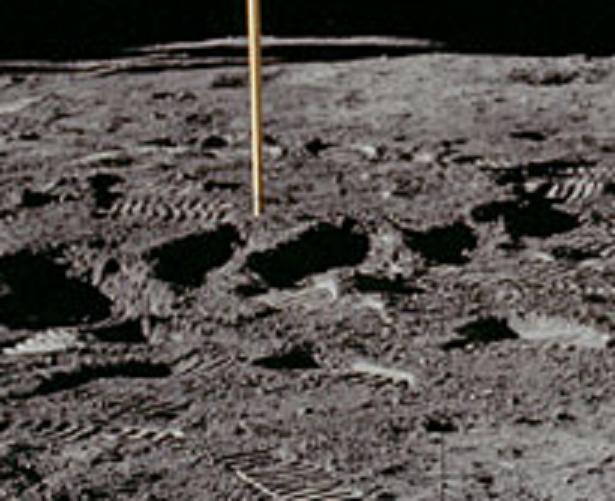 And this close-up of the photo on which Buzz is saluting the flag shows no evidence of shadow for the pole of the flag either. |
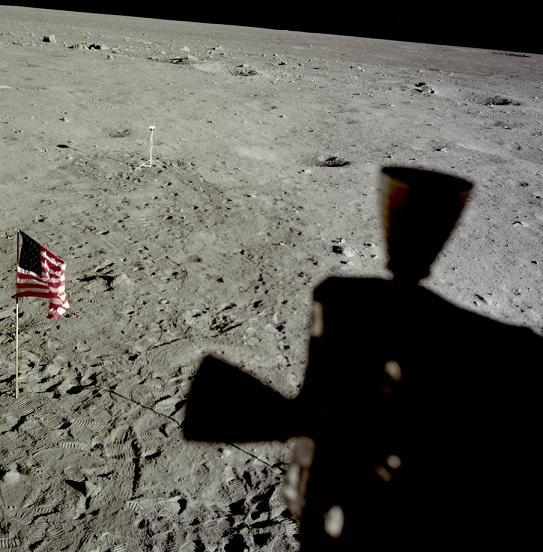 And on this photo (AS11-37-5468), the flag still appears differently |
 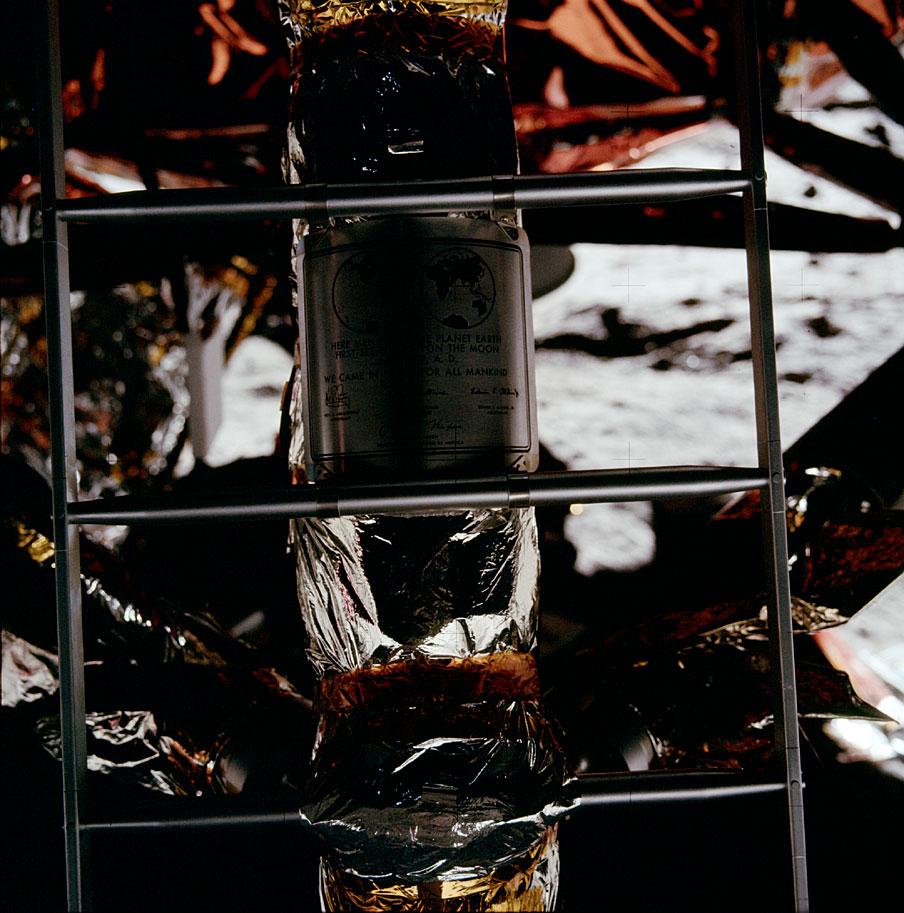  On these three photos (AS11-40-5897, AS11-40-5898, and AS11-40-5899); Armstrong takes three photos of a metallic plaque fixed on the ladder. The two first photos have a bad exposure, and the plaque is hardly visible, but on the third photo miraculously, he found the good settings (with no way of knowing which one was the good), and the plaque suddenly becomes clear and legible. |
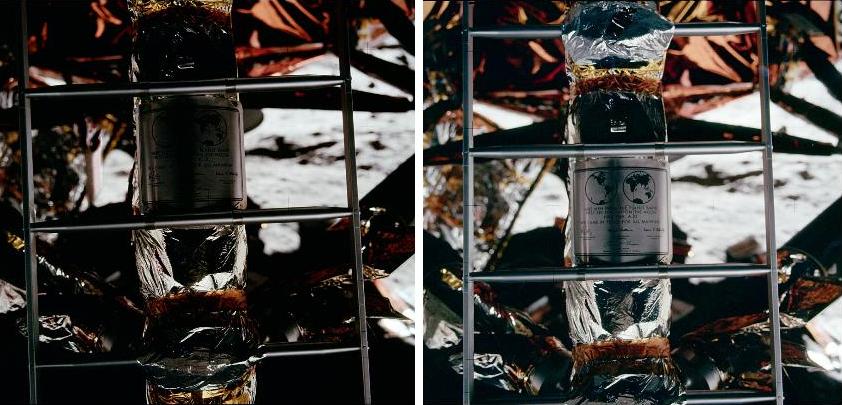 There is just a little problem; on the two first photos of the plaque, we can see an object we can't see on the third photo with the good luminosity. You don't see what it is?  Let me help you. It's a vertical object on the left and behind the plaque. As the attention of people is focused on the plaque which has miraculously become clear, they don't notice the disappearance of this object. But there is still something else we can observe: the rungs of the ladder are lower relatively to the background on the last photo than on the previous photos; but the ladder has a comparable size on the photos. That means that the camera has been elevated on the last photo; so Armstrong removed the camera from his breast to elevate it on the last photo, and he still managed to improve the settings of the camera? What a talent! |
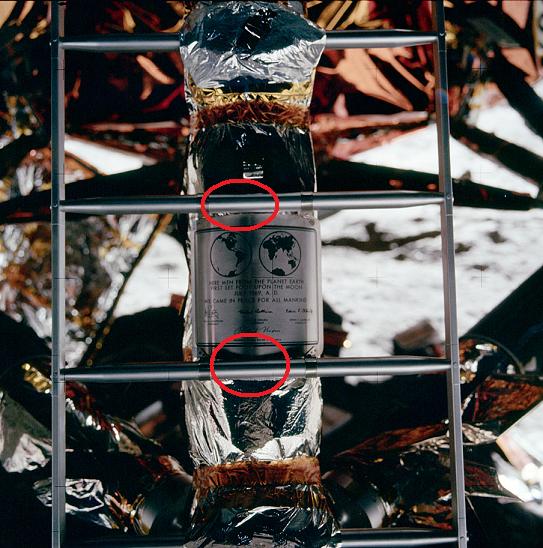 On the third photo on which the luminosity of the plaque has suddenly become good, why is there a narrow strip which remains dark? Why this strip, since the upper and lower rungs are brilliant all along, including at the place of the dark strip? In fact, this strip is not dark, but green; they have put some sort of paint on the plaque in a narrow strip, so that this strip remains unlit. Without this paint, the plaque would be entirely clear and legible. 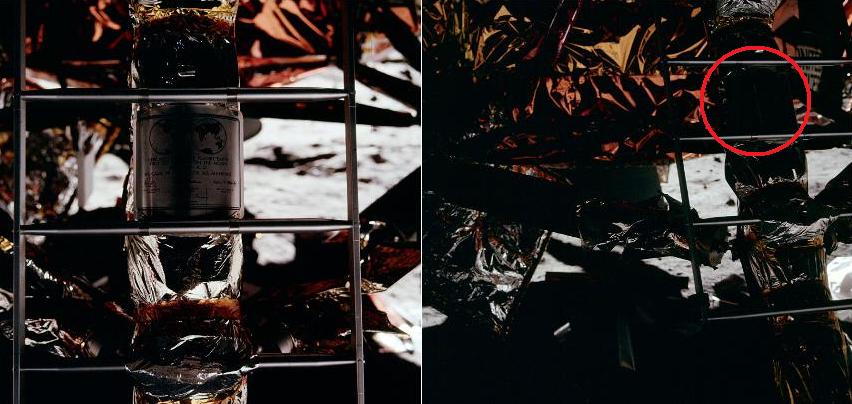 On the photo AS11-40-5900 (right) the commemorative plaque appears entirely black unlike on the photo AS11-40-5897, on which it may not be very clear, but it is not completely dark. Yet, on the photo AS11-40-5900 we see less of the brilliant lunar ground than on the photo AS11-40-5897; consequently the camera had to have a longer aperture time on the photo AS11-40-5900 than on the photo AS11-40-5897 to adapt to the global luminosity of the photo.  Thence there is no reason why the luminosity of the commemorative plaque would be much less good on the photo AS11-40-5900 (to the point of being completely black) than on the photo AS11-40-5897. Especially since the luminosity of the ladder's rungs is comparable on the two photos. 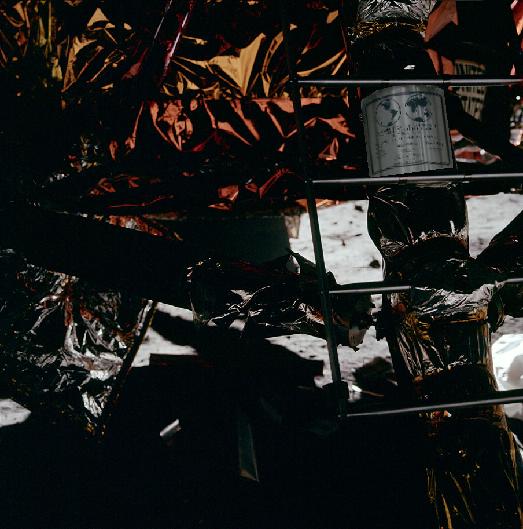 So, on the photo AS11-40-5900, the commemorative plaque might not be very clear, but it would not be completely dark. |
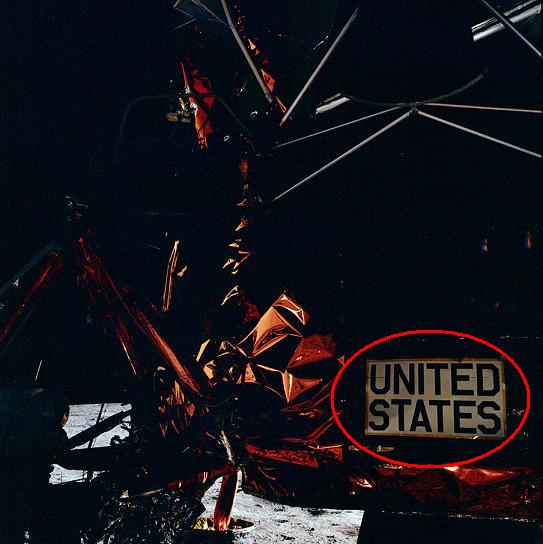 Another example in which the fakers played with the exposure of the photo is AS11-40-5894. Here the lem appears almost completely dark, very poorly exposed, but what's weird is that the US plate appears clear like it was well exposed whereas it is surrounded with black! Is the Hasselblad able of making selective exposure?  If the plate had appeared the way I represented it on the photo of the right of the double view above, it might have been normal: On my modified photo, the plate is only partially lit, and there is a part outside the plate which is also lit in a coherent way with the plate. But the fact that the plate is completely lit (left on the double view), whereas everything is black on the immediate neighborhood of the plate, seems very little probable...so little probable, that we can even call it impossible! |
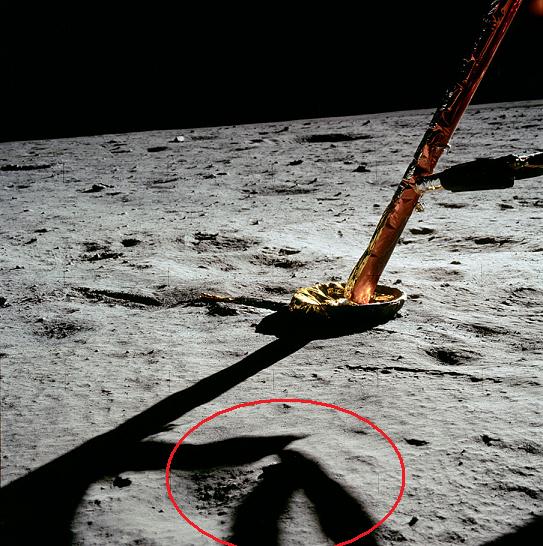 On photo AS11-40-5870, what is it the shadow of? It looks very strange! |
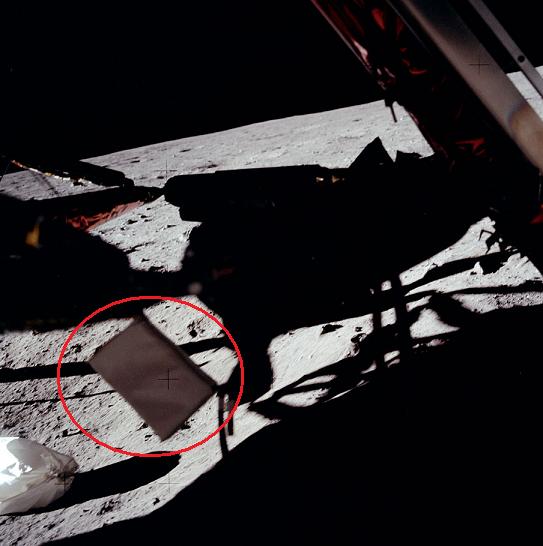 On photo AS11-40-5871, what is this strange object? An UFO? |
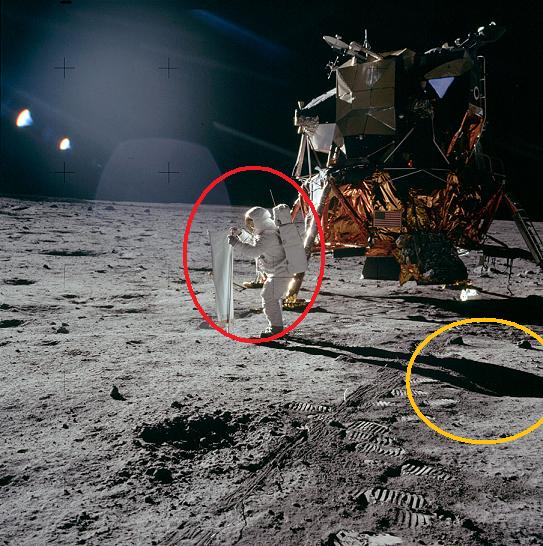 On AS11-40-5872, the shadow does not correspond with what it is supposed to be the projection of. 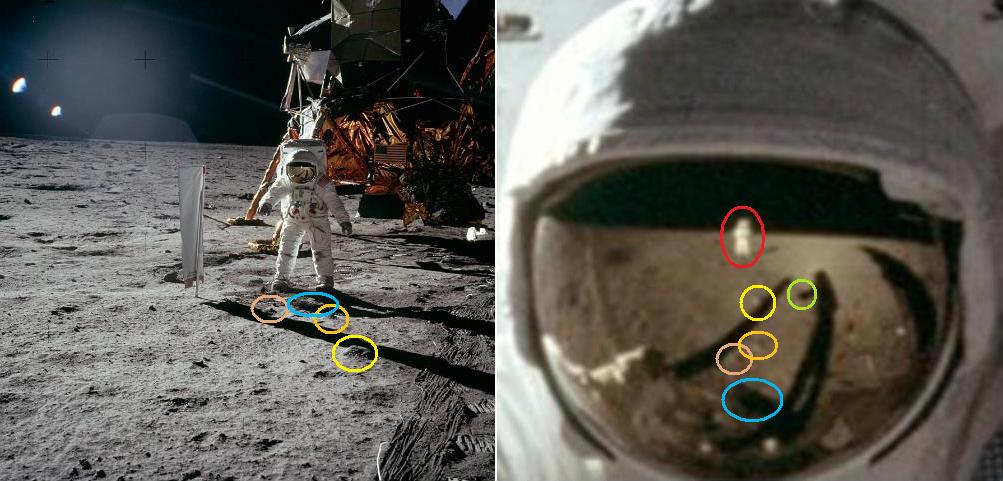 On this double view made with the photo AS11-40-5873, there is the photo on left, and what we see in the visor of the astronaut on the right. I have circled with different corresponding colors artifacts which are visible on the photo and the visor of the astronaut. We can see that there is an incoherence in the position of these artifacts between the photo and the visor. There is a black hole which is before two stones on the visor, but not on the photo. There is a stone I have circled in yellow which is almost at the level of the shadow of the extended arm in the visor, but not on the photo, since the shadow of this arm is not even visible on the photo. We can see the photographer (I have circled in red) in the visor. On this visor we can see that the photographer is way beyond the end of the shadows. But on the photo he is obviously before the end of these shadows.  But the shrewdest incoherence on this photo concerns the arm. In the visor, we can see that the arm of the astronaut points toward the area comprised between the SWC's foot and the beginning of its shadow. But, on the photo, this arm doesn't seem to point toward this area, it seems more horizontal. This fact is confirmed by the shadow of the arm in the visor which effectively doesn't point toward the bottom of the SWC's shadow, but higher. 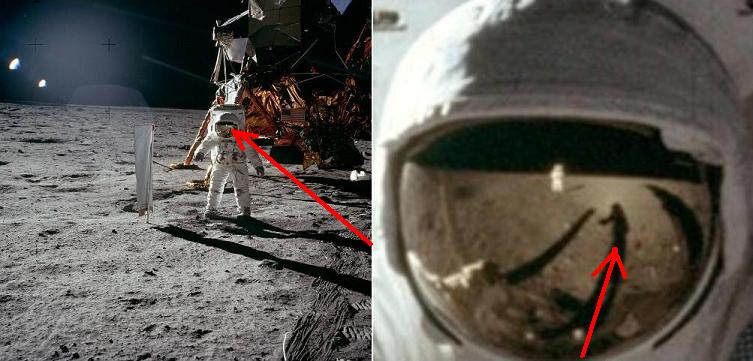 Last incoherence: On the photo, the astronaut's shadow is completely on his side, so it should appear on the extreme right of the visor. Instead of that it appears not far from the middle of the visor, like it was almost facing the astronaut, just a little in bias. |
 There is something else I have noticed: On the left leg of Buzz (the right one for us) we can see a letter 'F' drawn on his suit. A letter 'F'? Like Fake? |
 On these photos (AS11-40-5878 and AS11-40-5879), we can see a footprint with a small rock ahead, and on the next photo the boot of an astronaut with a rock which looks bigger than the previous rock in comparison with the previous photo. So we logically think that the rock on the second photo is not the same as the one on the first photo. |
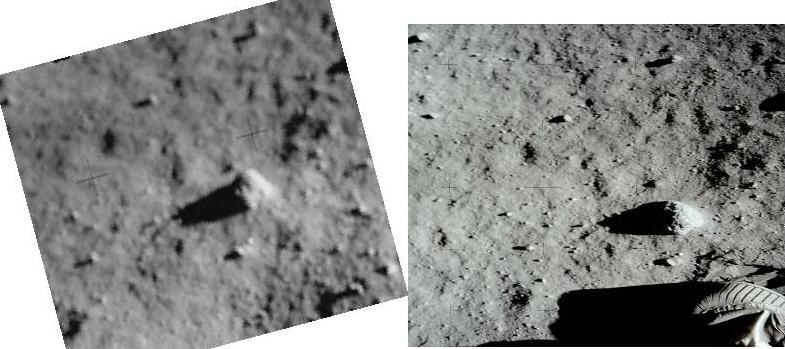 But when we take a close-up at the rock of the first photo and we compare with much attention the artifacts which surround the rocks on the two photos, we can see that these artifacts are the same, and therefore it's very surprisingly the same rock on the two photos! |
 So, I have reproduced the boot on the first photo at the same size it had relatively to the rock on the second photo, and we then can see that there is a little problem, for this boot is much smaller than the footprint it is supposed to have made. We are entitled to deduce that there must be lunar giants on the moon! |

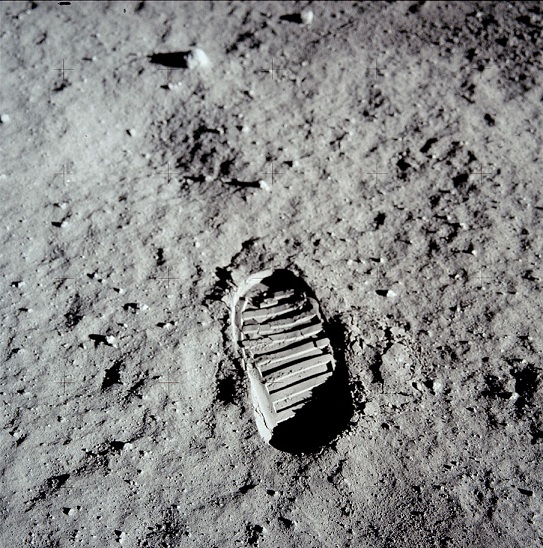 This photo is the photo AS11-40-5877, and shows a footprint which would have been left by Armstrong on the moon. 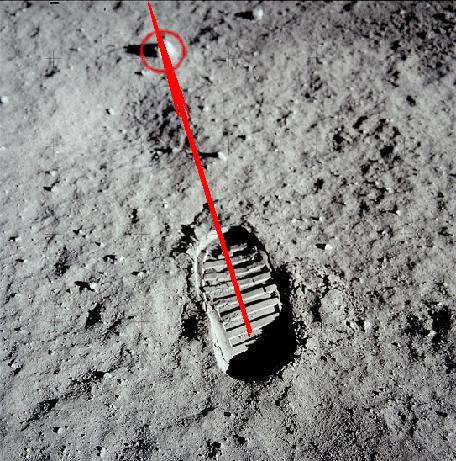 We can see a little rock I have circled, and the footprint is pointing toward this rock (i.e. the direction footprint->rock is the same as the direction of the footprint). 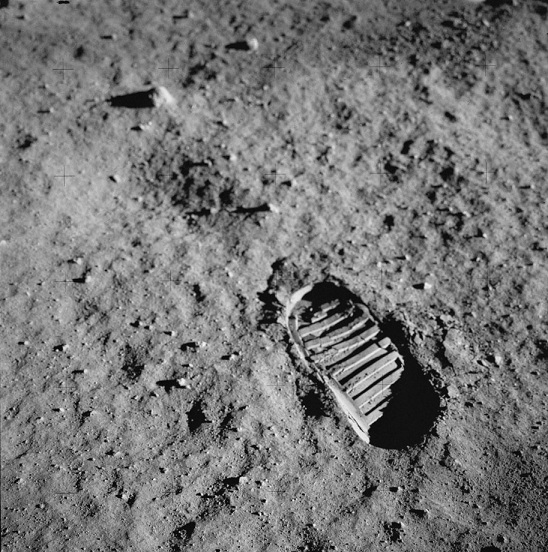 We can also see this footprint on the photo AS11-40-5878. But this footprint seems narrower than on the previous photo. Would the footprint have changed between the two photos? May be not, for we can see that the distance between the footprint and the rock has also increased. In fact, if we compare the two photos, we can see that there is a general dilatation along the direction of the footprint on the whole photo. The first impression is that it could be explained by a change of the angle of view between the two photos. So, it might no seem as abnormal as it seems? Really? 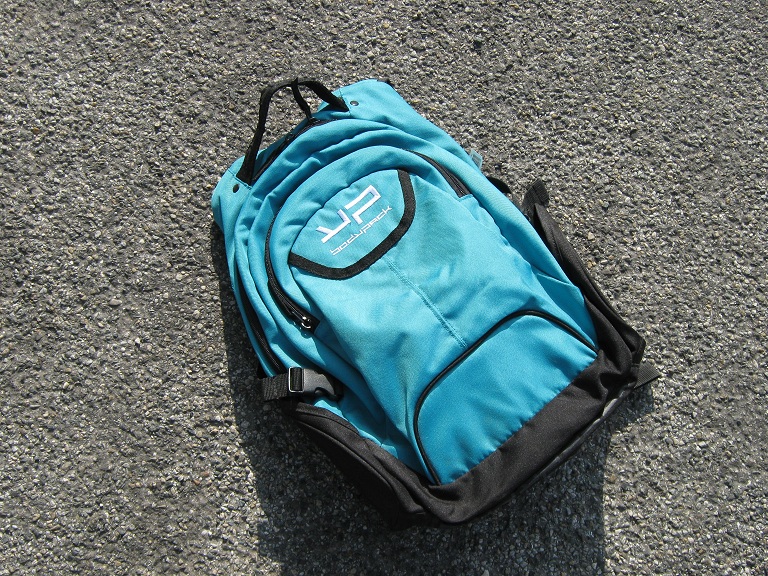 I take a bag, I put it in on the ground, but in bias relatively to myself. I first take a photo standing up. 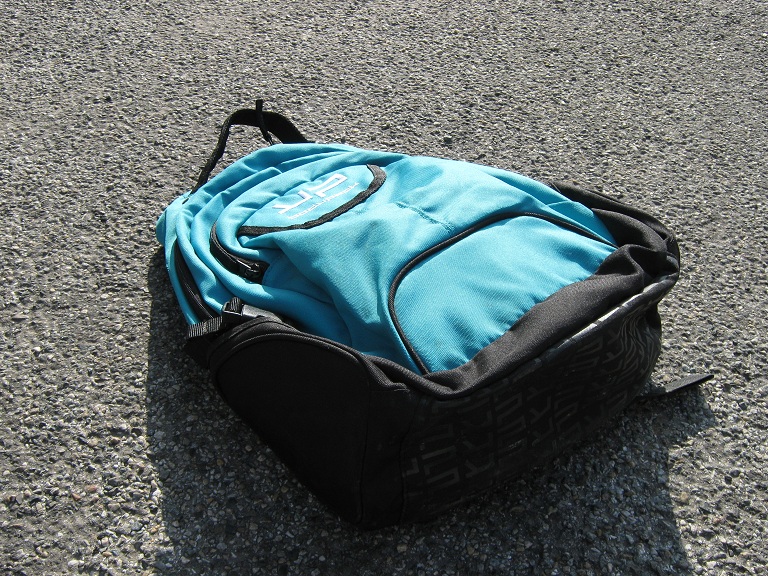 I take a second photo, this time by bending down to change the angle of view. If we compare the two views, we can see there effectively has been a dilatation on the bag by the fact of the change of angle of view, but this dilatation is along the horizontal of the photo, and not along the direction of the bag. On the second photo, the bag does not appear dilated like the (supposed) footprint on the second photo of Armstrong's footprint. 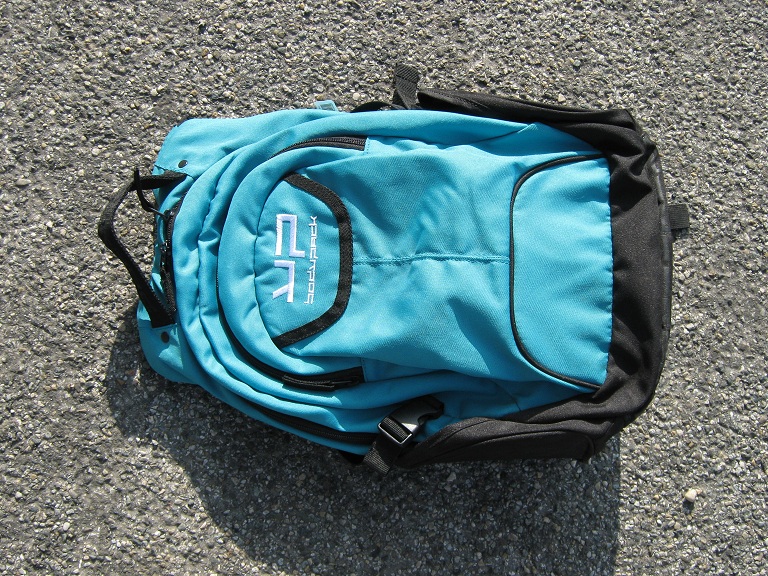 Now, I put the bag horizontally relatively to myself, and I take a first photo standing up. 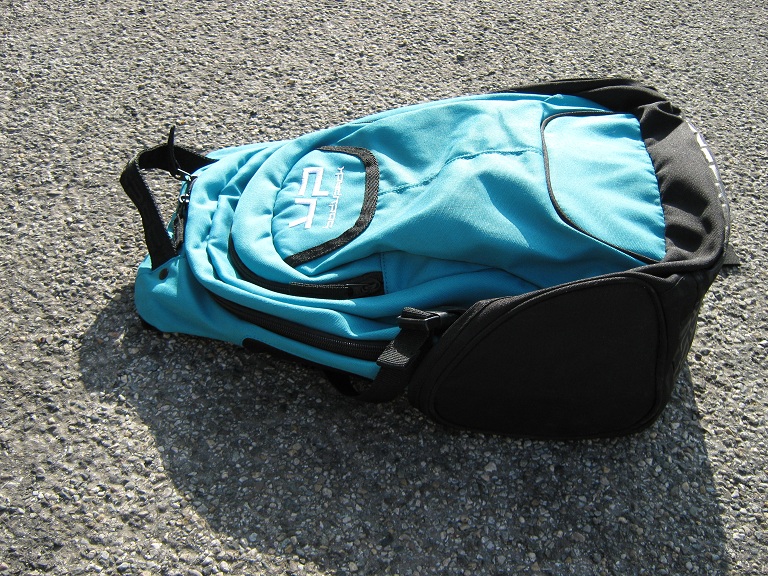 I take a second photo bending down to change the angle of view. Now, if we compare the two photos, the dilatation is this time along the direction of the bag...which is normal, since the direction of the bag now is parallel to the horizontal of the photo.  Now I rotate of 45° the photo with the horizontal bag taken when I stood up...  ...and also the photo I took when I bent down. If I compare them, I now have a dilatation of the bag along its direction which is not the horizontal. Of course, it would be possible to apply the same treatment to the second photo, AS11-40-5878, so that the dilatation of the footprint appears along its direction, without its direction being the horizontal of the photo. But the photos are supposed to be the original ones, directly taken by the hasselblad on the moon, and not manipulated photos obtained from the original photos, aren't they?  But, it is not the only problem with these photos. Even if we admit that the second photo would be obtained by a manipulation from an original photo, it still does not explain everything. See the shadow of the rock: It bends more toward the perpendicular to the direction of the footprint than toward its direction. It means that, on the second photo on which the footprint appears narrowed, the rock's shadow should also be shortened. ...But you can see that it is not (I show windows of the same size extracted from the photos), it appears longer to the contrary. |
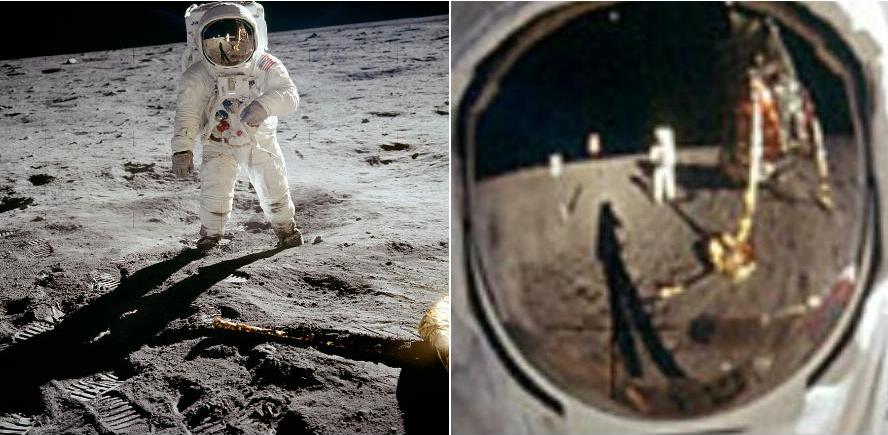 On this couple of photos we can see the photo of the astronaut taken frontally (AS11-40-5903), and a close-up on his visor. Several anomalies can be seen on his visor relatively to what we can see on the photo.  First, on the photo the astronaut folds his left arm, but the visor tells us it is stretched instead; so what's right, the photo or the reflection? 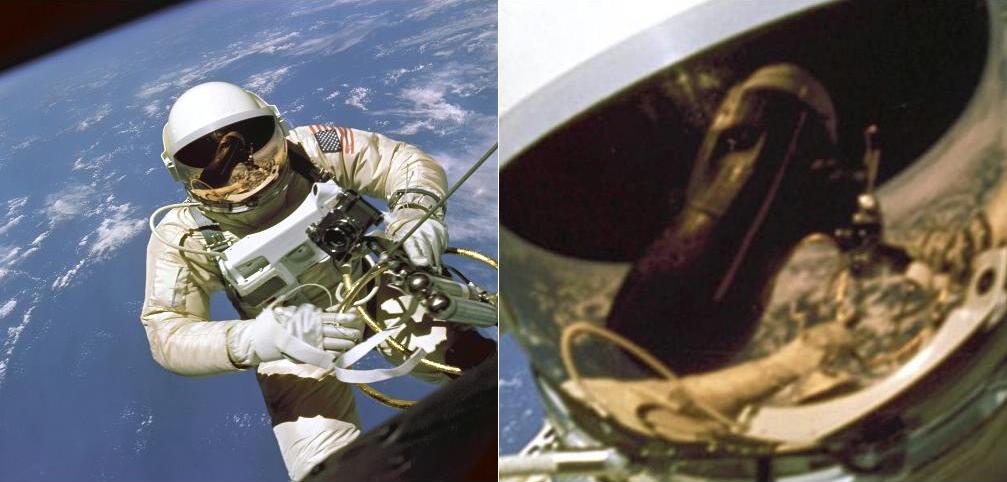 Now, someone has asked me if I was sure that the folded arm could not look that way in the visor because of the spherical shape of the visor, and he has proposed me this photo of a Gemini mission in which an arm is folded on the photo, but it is not so obvious it is on the reflection. |
 In fact, the arm we see in the reflection is different from the arm we see in Buzz's visor. I have colored the forearm in yellow on the photo and on the reflection of the visor, and the arm in pink on both. The forearm is almost perpendicular to the visor, and the consequence is that the shoulder, the forearm and the elbow are confused, and we can't see the articulation between the arm and the forearm. On the other hand, the arm is well oriented to be well visible. |
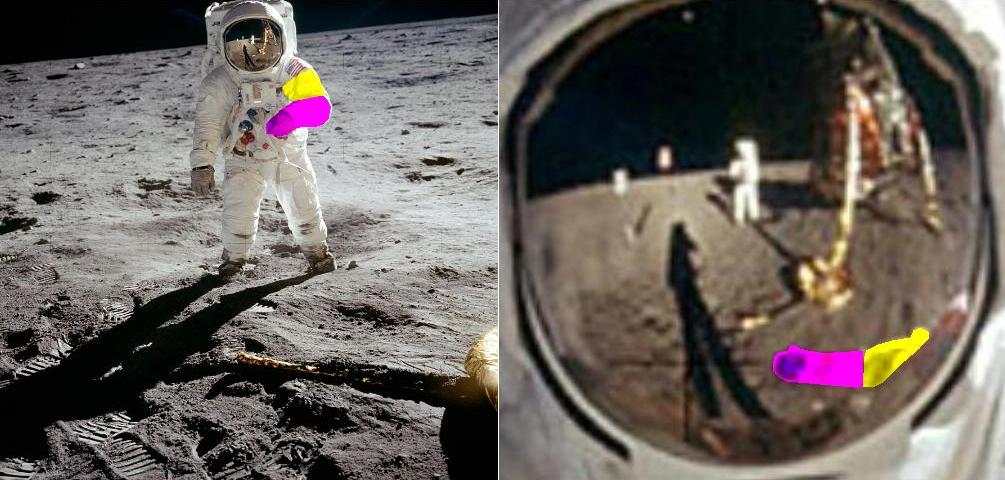 On the photo with Buzz, I have colored the forearm in yellow on both the photo and the visor's reflection, and the arm in pink on both. Here, we can clearly see the forearm on the visor, as well as the articulation between the arm and the forearm (in other words, the elbow). |
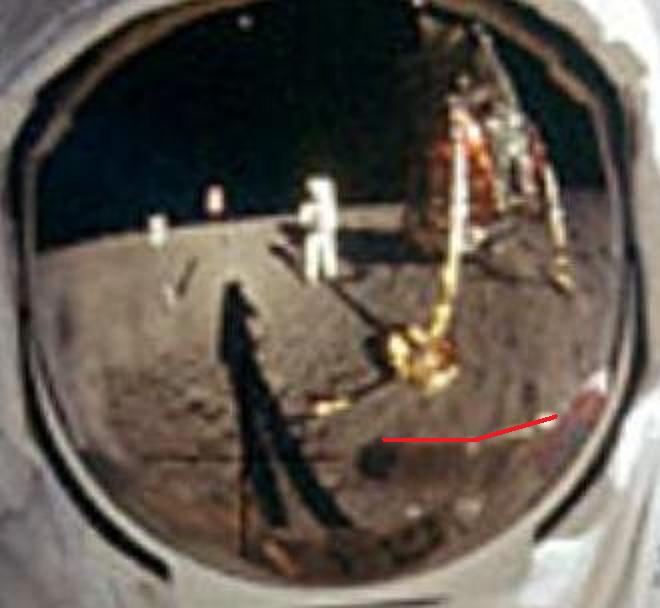 Now, you are going to tell me: How can you be sure that the two parts you are showing don't both belong to the arm, and that the forearm is not visible like on the Gemini photo? Well, I'm sure because the two parts make a slight angle; so unless the arm has been broken (and there has been no report of a broken arm in this mission), these two parts cannot belong to the arm, and therefore one part is the arm, and the other part the forearm, or rather a part of the forearm (it is not totally visible). It is then very clear that the arm and the forearm don't appear relatively to each other the same way on the visor as they do on the photo! |
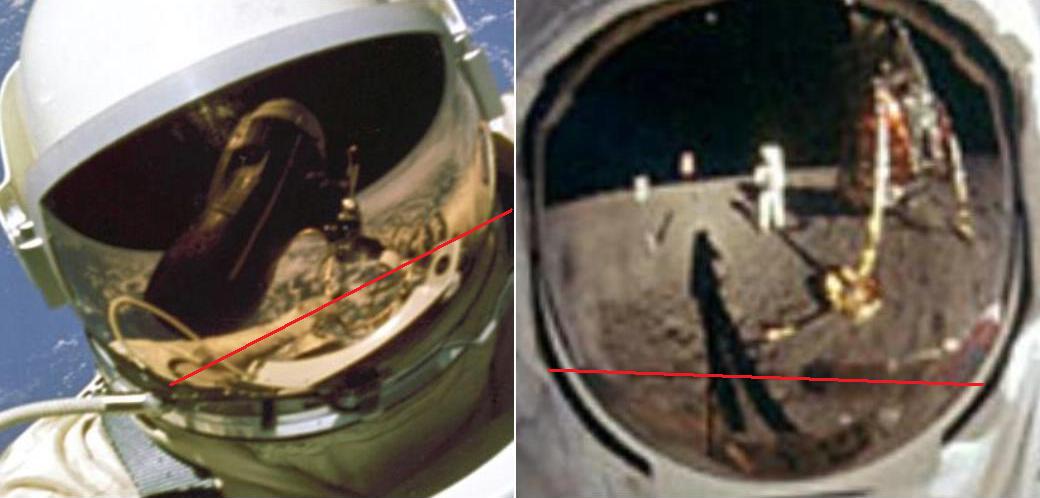 If we look at the orientation of the arm relatively to the visor (take into account that on the Gemini mission the astronaut is bending his head), we can see that this orientation is different on the two visors. |
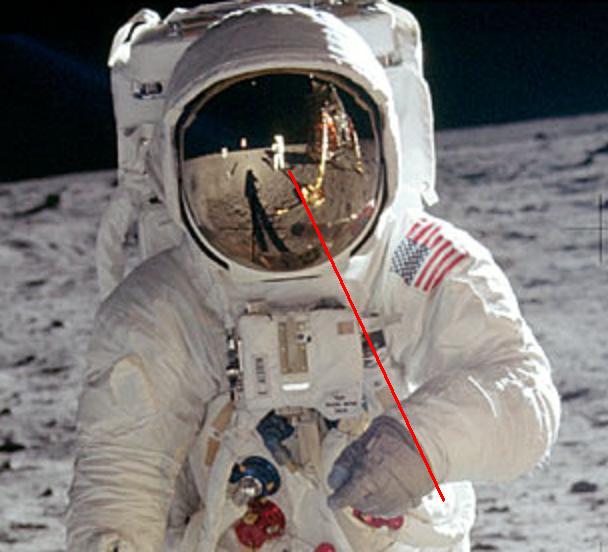 If we draw a line from the corners of the camera on the photo and on the reflection, we can see that this line cuts differently the arm on the photo and on the reflection. This puts into evidence that the arm on the reflection is too long (and incorrectly oriented also). This comes from the presence of the forearm. |
 This photocomposition shows what we should see: Like on the photo of the Gemini mission, the forearm is (almost) perpendicular to the visor, and the forearm should almost be hidden (by the shoulder). We should only see the arm, and not the forearm; and the arm would also be longer because it is more parallel to the visor than when it is stretched. It would also be closer to the bottom of the visor because of its direction of projection on the visor. |
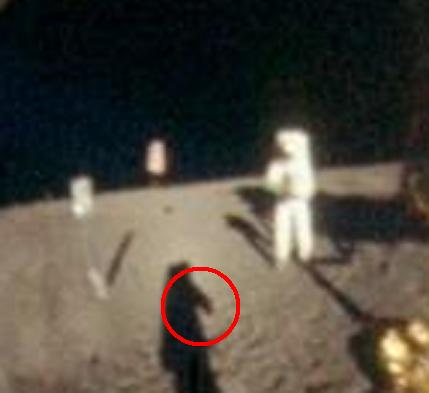 Besides, the same arm also appears extended on Buzz's shadow in the reflection of the visor. If the reflection of the shadow of his arm in the visor was appearing like it should, it would appear like what I have represented on the right of the double view, and not like what we can see on the left of the double view.  Now, observe the orientation of Buzz on the photo; he appears slightly turned counter-clockwise; as Neil is taking the photo, that means that Buzz is slightly turned counter-clockwise relatively to Neil. 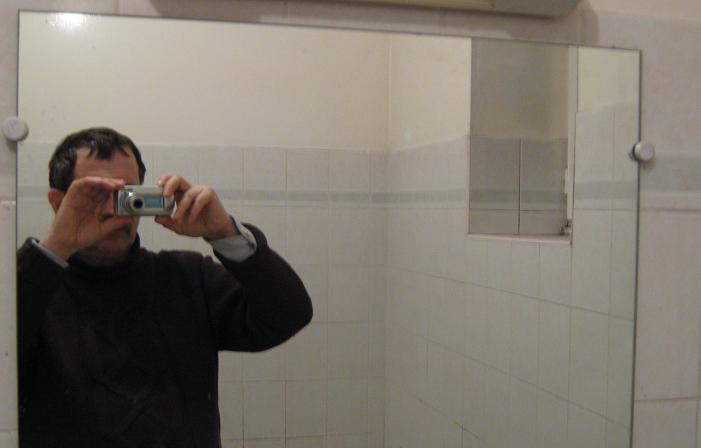 Now, orient yourself relatively to a mirror so that it appears turned counter-clockwise relatively to you, and you'll see that you also appear turned counter-clockwise in the mirror. Of course, Buzz's visor is not exactly a mirror, because of its curvature, but Neil appears on the middle of the visor, on a part of it which has the same orientation as Buzz. 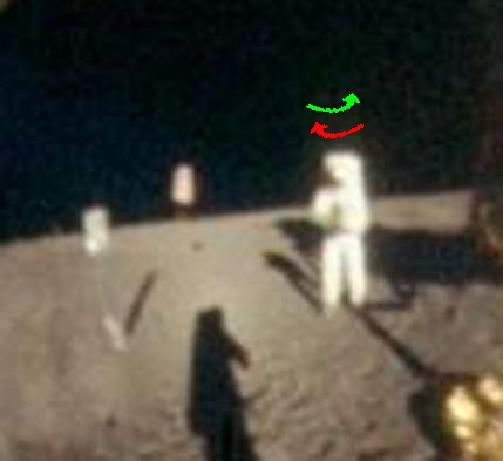 It means that Neil should appear turned counter-clockwise in the reflection of the visor, that is in the direction shown by the green arrow, but he appears turned clockwise instead, that is in the direction indicated by the red arrow, contrary to the green arrow. So, instead of appearing like what we see on the left of the double view, the reflection of Neil Armstrong should appear with the orientation I have corrected on the right of the double view.  Compare the orientation of Buzz's shadow with the orientation of his shadow in the reflection of the visor; it is obvious that the shadow in the reflection of the visor appears too straight, not bent enough relatively to the shadow of the photo. 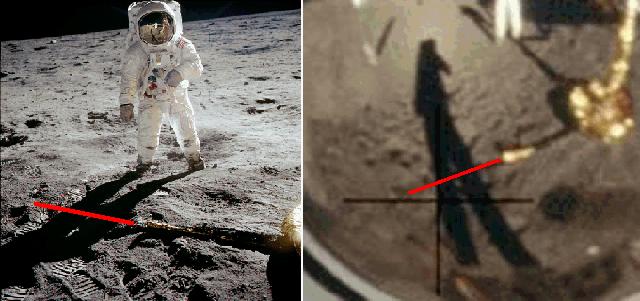 And also, if we draw the line prolonging the probe of the footpad, it cuts Buzz's legs differently on the photo and on the reflection of the visor; on the photo, his crotch is placed higher relatively to this line than on the reflection of the visor. 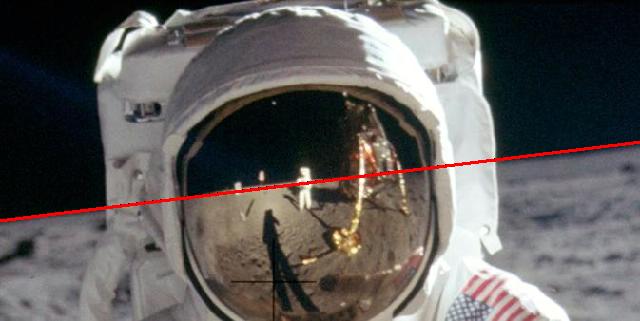 If we draw a line along the horizon line behind Buzz, we can see that it is strangely in continuity with the horizon line we see on the reflection of his visor.  On the reflection of the visor, because of its sphericity, transversal lines appear bent on the sides. The horizon line in the reflection of the visor must appear bent on the two sides; but it appears more bent on the left side than on the right side, whereas it should appear bent the same on the two sides.  You can see, in the reflection of the visor, that Neil has his legs right on the shadow of the LM's leg. The shadow of the leg stops just on Neil's feet; but it shouldn't, it's not because Neil is on the path of the leg's shadow that it should stop on Neil, it should continue on Neil and appear on him. So, instead of appearing like what we see on the left of the double view, it should appear like what I have represented on the right of the double view, i.e. the leg's shadow should appear on Neil. 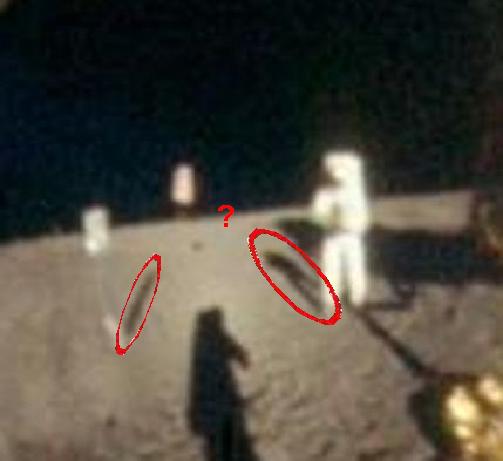 On the reflection of the visor, you can see that the solar wind collector has a shadow, Neil has a shadow, but, strangely, the flag has no shadow! 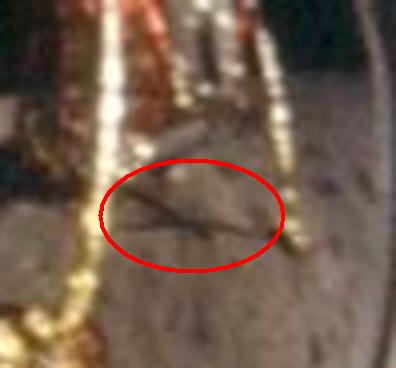 On the reflection of the visor, we can see another leg of the LM on the extreme right, but we can see that this leg has an abnormal shadow. On this double view, I show, on the left, a normal view of the solar wind collector, and, on the right, the solar wind collector as it is seen on the reflection of the visor, and we can see that it appears abnormally in the reflection of the visor; between the top and the bottom of the collector, it appears almost transparent. 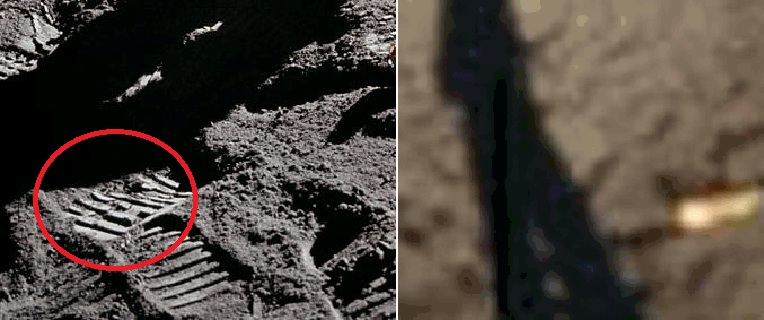 Compare the footprints of the right of Buzz's shadow (after the probe) on the photo and on the reflection of the visor; on the photo, the footprints are oriented in several directions, and, on the reflection of the visor, they are oriented only in one direction. 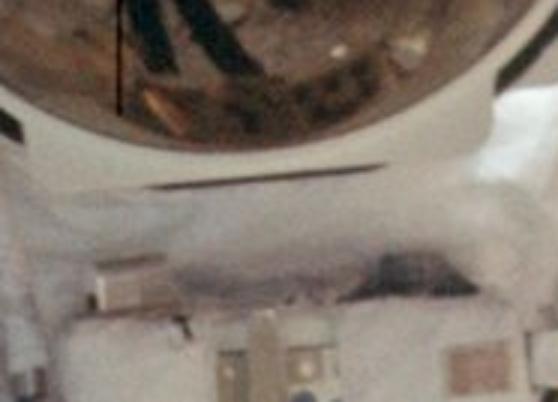 Compare the top of the camera with its reflection which appears on the extreme bottom of the visor; we don't see on the reflection buttons which are on the camera's top. 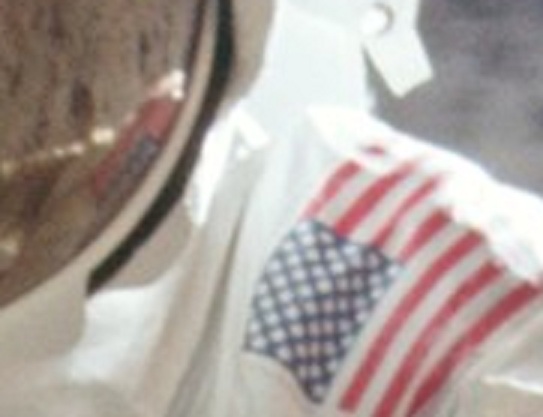 On Buzz's shoulder, there is an american flag of which we can partially see the reflection in the visor. 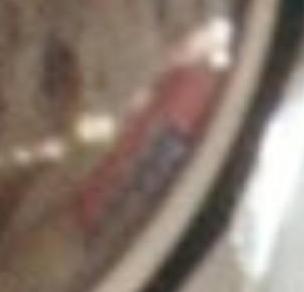 Now look at this reflection: We can distinguish the white stars over the blue background; but, on the part of the stripes, we only see red, we can't make out the white stripes from the red ones. So, the photo 5903 taken on the moon? Just dream about it! |
 On the photo AS11-40-5920, the shadow of the flag is not oriented like the flag itself; the flag appears oriented on the right whereas its shadow appears oriented on the left. |
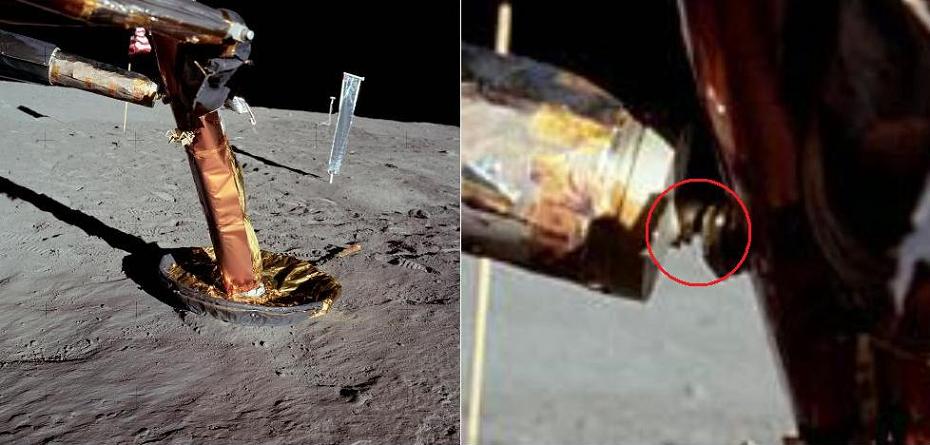 On the photo AS11-40-5920, we can see through the articulation of the strut to the leg of the LEM; they are connected through the operation of the holy spirit! 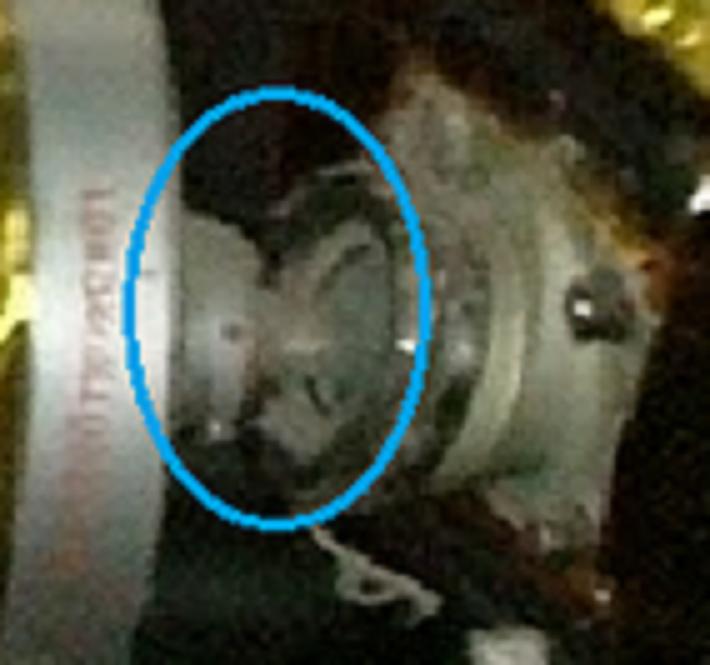 On the show model, we do see an actual contact between the two struts. 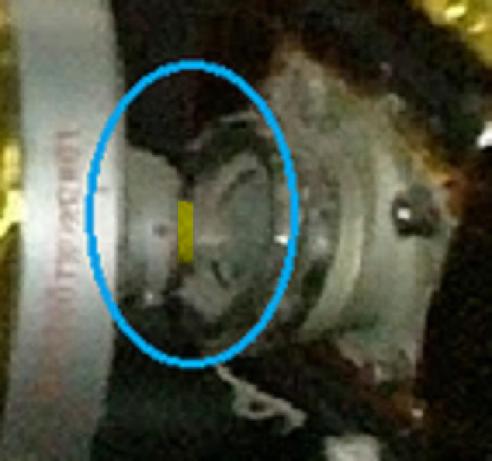 I have highlighted in yellow the part of the contact which is visible on the show model, and absent on the Apollo photo. 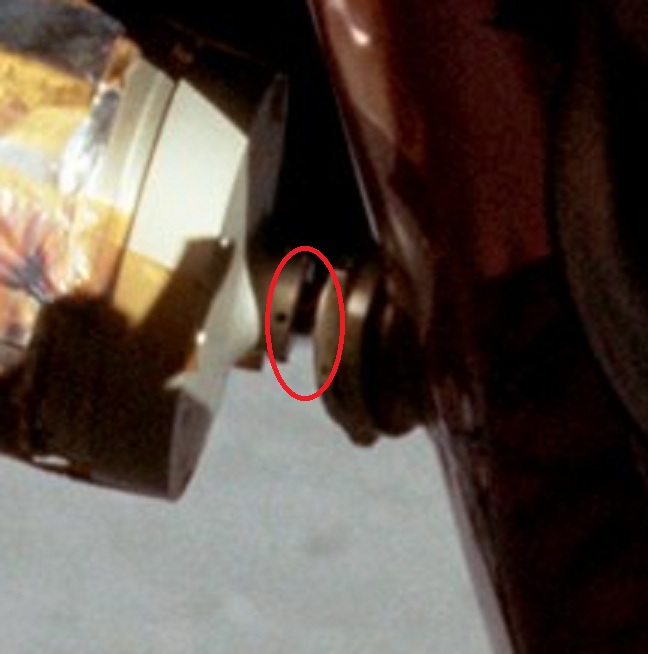 Then the Apollo believers have used as an argument that the contact was here, but not visible for being shadowed; on the moon, do they stress, the shadows are very black. 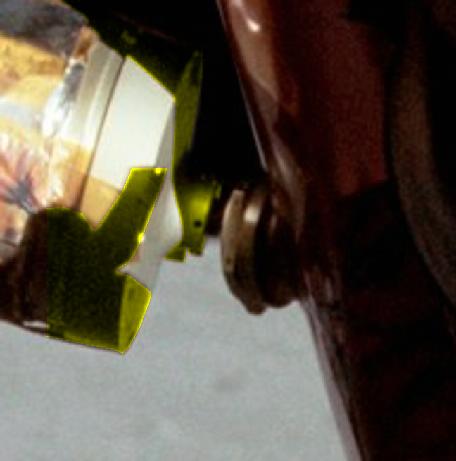 Oh yes, very black? Yet, I have highlighted in yellow parts of the strut which are shadowed; they are dark brown, but not black; if they were black like the lunar sky, they would not be visible, they would melt with the lunar sky.  On this corrected photo, I show how this junction should appear: It would be dark brown, but not completely black, it could be distinguished from the black lunar sky. |
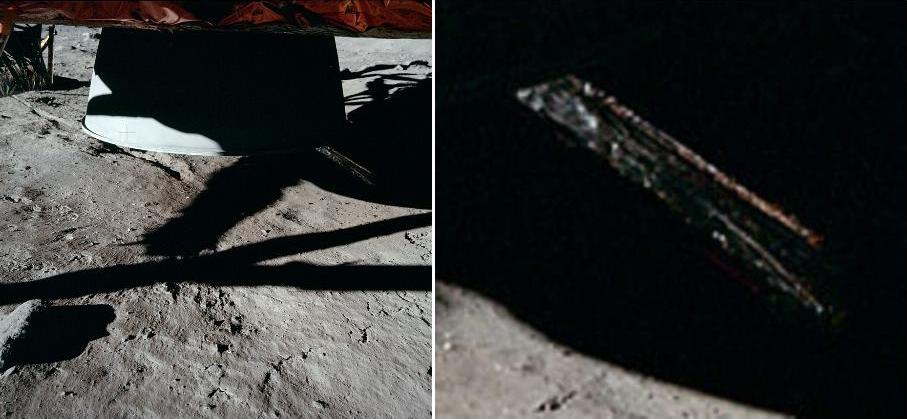 What is this brilliant object on photo AS11-40-5921; it is glowing in the shadow; normally it should be dark; if it isn't, it means it is emanating light from itself! |
 This is a close-up of the foot of the LEM on photo AS11-40-5926; is it really what supports the weight of the LEM? It must be a joke! 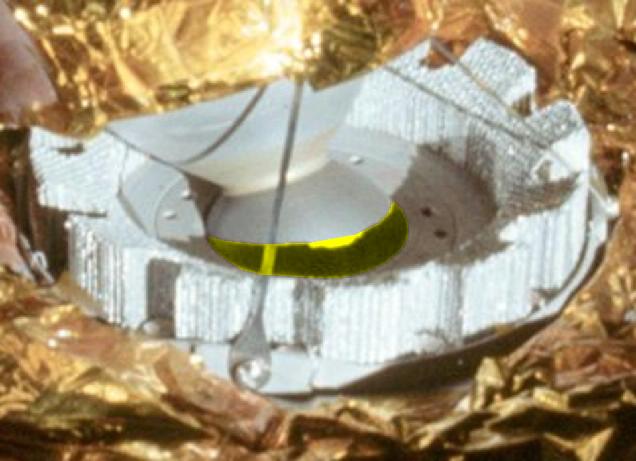 We can see an interval between the ball's cover and the socket which is the evidence that the ball is too small and not fitting in its socket. The Apollo believers have asserted that the ball was here, but not visible for being shadowed. But the articulation on the show model obviously does not look like the same. 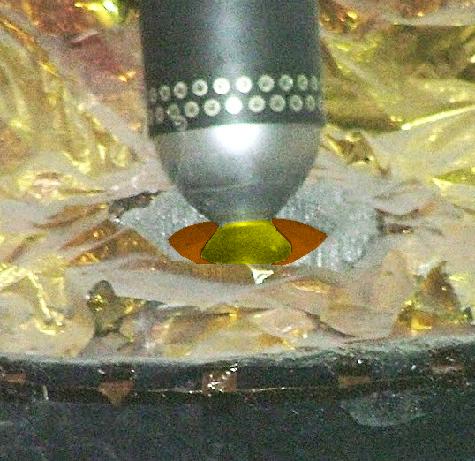 What is different is that the ball's cover (I have highlighted in yellow) makes a close contact with the socket (I have highlighted in orange). 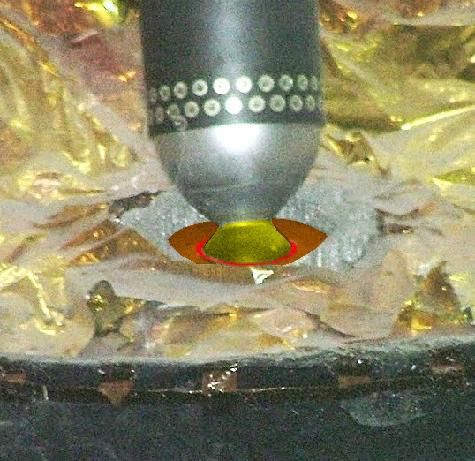 Between the two, we see a close contact (I have represented with a red circle), we don't see an interval between the ball's cover and the socket like the one we see on the Apollo photo.  Here is what we should have seen on the Apollo photo, a close contact between the ball's cover and the socket, which gives the evidence that the ball really fits in its socket, and is not undersized. 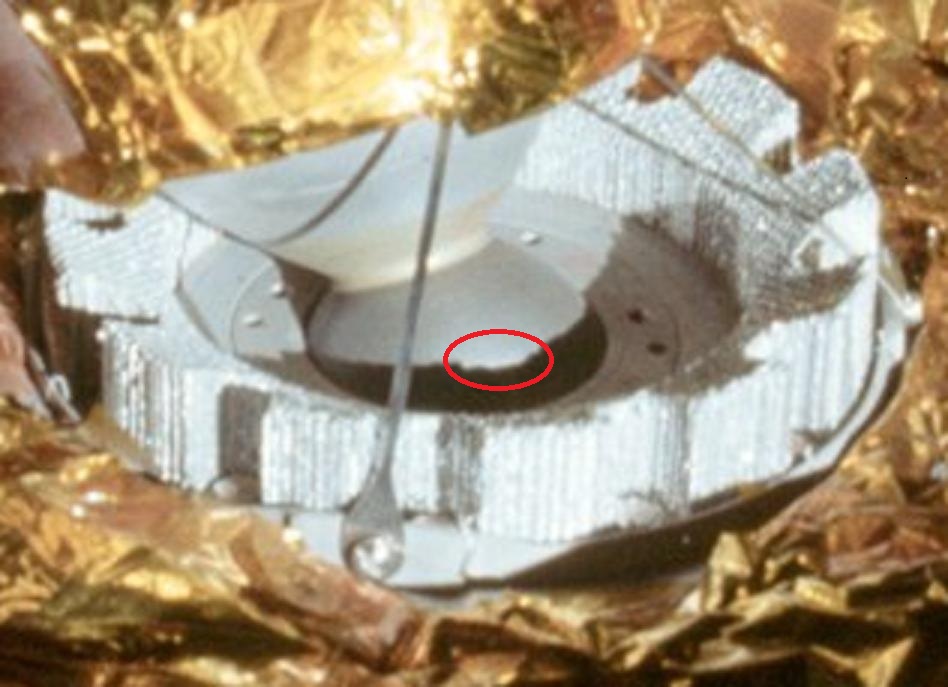 And, if the ball is entirely shadowed, then why do we see this lit bit I have circled? Furthermore, let's compare the articulation of the Apollo photo with the one of the show model: On the show model, this articulation is metallic, and, on the Apollo photo, it is plastic, or eventually painted wood. Plastic or wood would not have stood a high temperature. |
 On these two photos (AS11-40-5927 and AS11-40-5928), the photographer is taking two photographs of the other astronaut working on the lem. On the second photo the photographer turns his camera on the left and the shadow of the photographer appears on the left. Apparently it seems normal. |
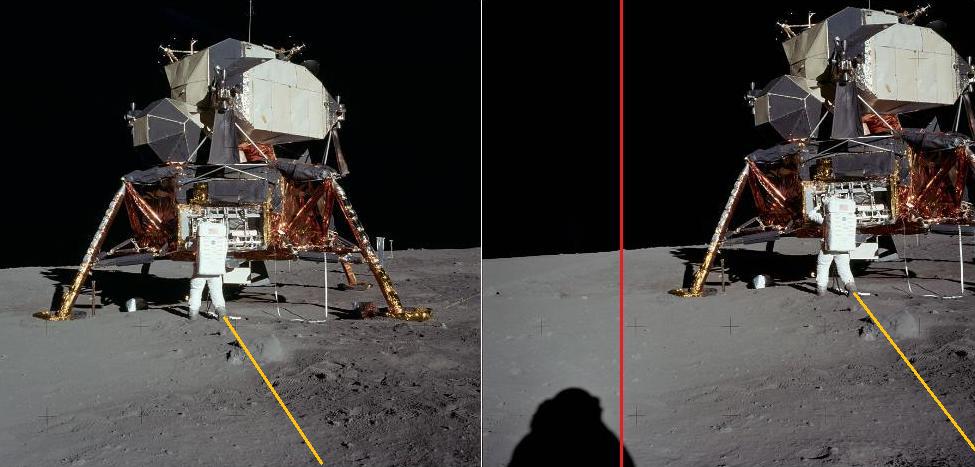 But if I draw a (red) line on the second photo which is at the same distance from the lem as the border of the first photo is from it, we can see that this line cuts the photographer's shadow. If the photographer had only made a rotation with his camera, we should see on the first photo the little bit of shadow which is on the right of this line. But if we draw a line from a foot of the astronaut to a stone in the foreground, we can see that this line rotates counterclockwise from the first photo to the second one; this is the indication that the photographer has moved on the left on the second photo, and so has his shadow relatively to the lem. This means that the photographer's shadow was a little more on the right relatively to the lem on the first photo, and thence a little more visible than the bit which is on the right of the red line. |
 On this double view, I show on the photo of the left how the photographer's shadow should have appeared on the first photo; a part of it should have appeared, not a big part, but a visible part. |
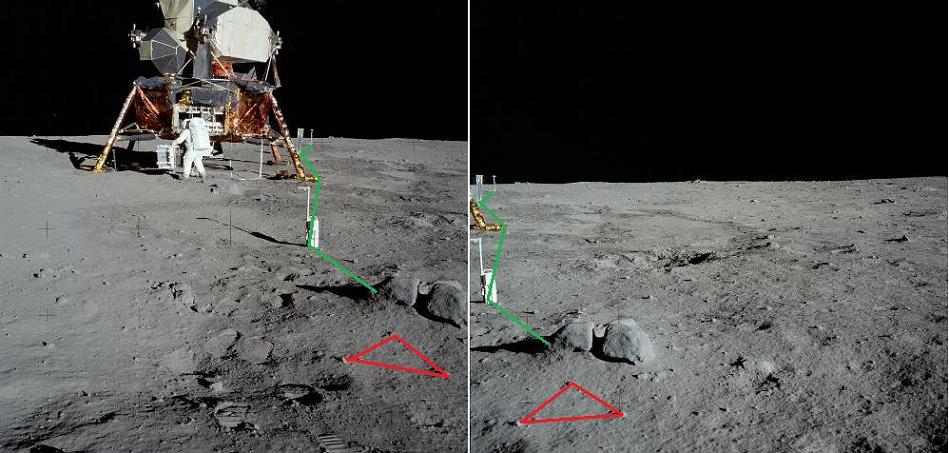 On these photos (AS11-40-5931 and AS11-40-5932), we can see a triangle of stones in the foreground. We can see that, on the second photo, the foreground and the background have both moved on the left and down, and they seem to have moved the same or almost, which means that the photographer must not have much moved, and mostly turned his camera. Yet, the triangle of stones has importantly turned; does it only come from the move of the photographer? 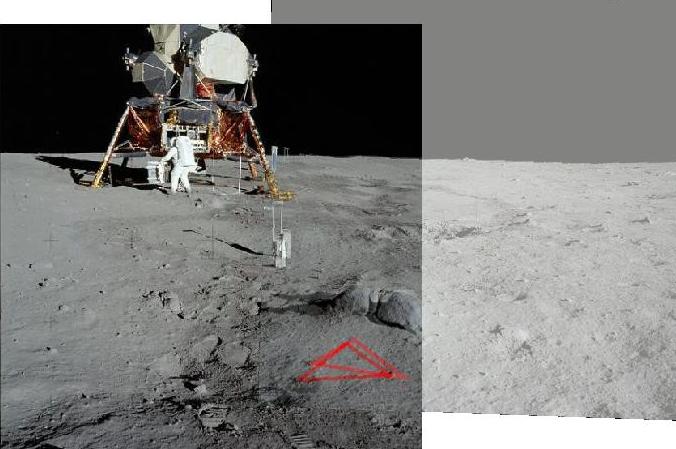 On a superposition of the two photos which superposes as well as possible the backgrounds of the two photos (which don't react to the move of photographer), we can see that the photographer has slightly moved on the right and forward (if we consider the white device which is between the foreground and the lem, the one which is the closer one belongs to the second photo). What's particular on this superposition is that there is one stone of the triangle which has moved consistently more than the two other ones, whereas it should have moved the same as the two other ones, for the three stones are roughly at the same distance from the photographer. The triangle of stones had to turn in reaction to the little move of the photographer, but here it didn't turn in a natural way; it's obvious that there is one stone which has been moved before taking the second photograph. |
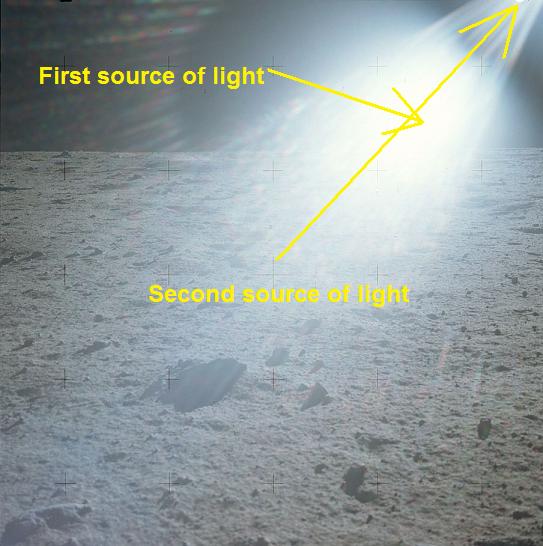 On this photo (AS11-40-5935), we can see a double source light indicated by the arrows. Would there be two suns on the moon? |
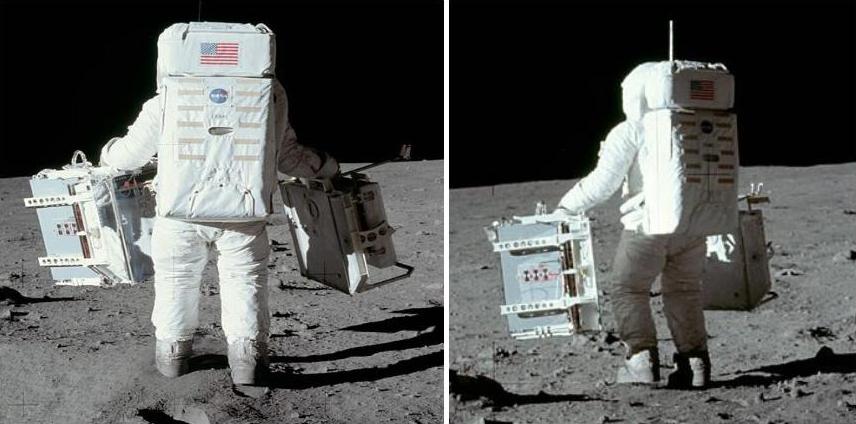 On these two photos (AS11-40-5942 and AS11-40-5943), the astronaut is carrying electronic devices. The problem is that the devices he is carrying on the first photo are not the same as the ones he is carrying on the second photo. Who made the substitution? |
 On the photo AS11-40-5942, the legs of the astronaut are both entirely shadowed from waist to ankles: yet the device the astronaut is carrying could not shadow them this way. |
 On the photo AS11-40-5945, we can see the astronaut with two devices. He has put one of them on the ground. 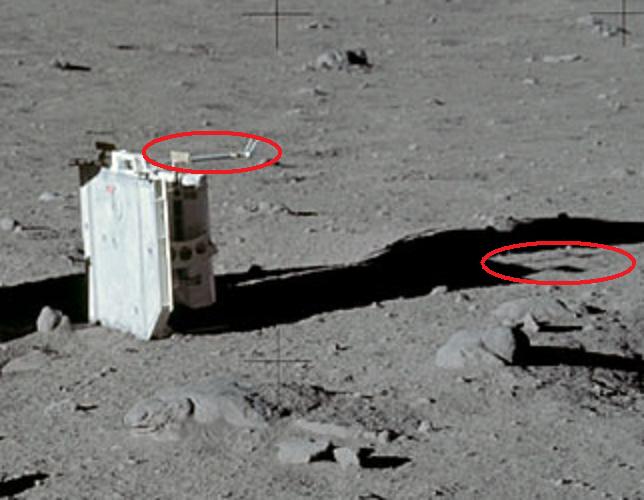 On the device on the ground we can see a sort of fork I have circled; this fork is on the left side of the device, but, on the shadow, it appears on its right side. |
 On the same photo, we can see the handle of the device the astronaut is carrying with his right hand, which means he is not using it to carry the device; so the question is: How is the astronaut carrying this device?  We can see on this photo that this device has no other handle. |
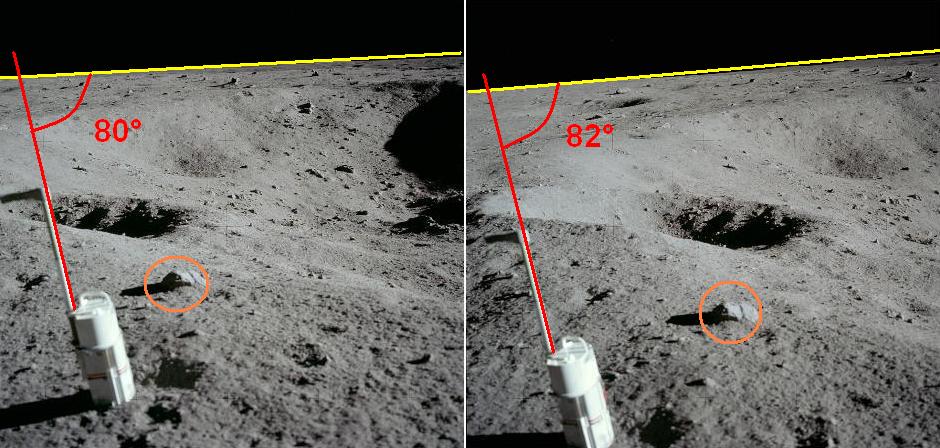 On photos AS11-40-5957 and AS11-50-5958, the photographer is walking along a crater. Between the two photos, he has moved on the right; this is visible for the rock I circled with orange has moved on the left relatively to a hole which is farther in the crater and on the right relatively to the white device which is closer. We can also see that the photographer moved forward between the two photos. Moreover the photographer pivoted his camera toward left, so he would have again the white device in his camera. I told myself that this device was not put there for nothing, and that it had to serve a purpose. 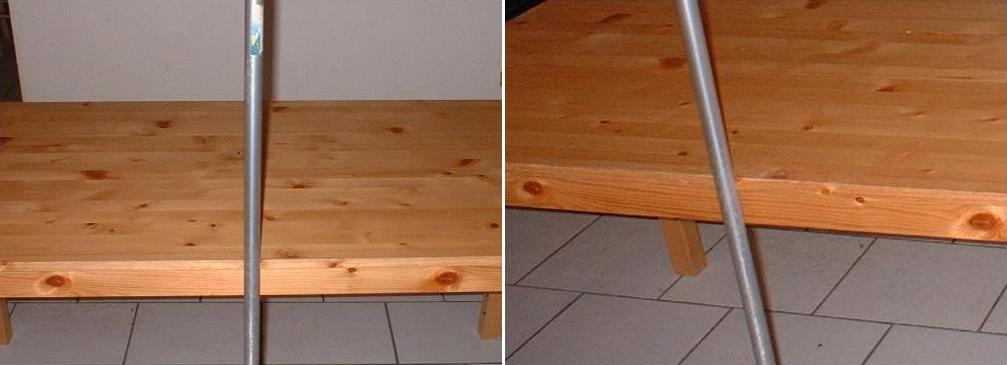 On this photo, when I move on the right relatively to a broom placed vertically against a table, this one shows a counter-clockwise optical rotation. This comes from the fact that the upper part of the broom is closer to the camera than its lower part, and so moves faster toward left than the lower part relatively to me, and this is what makes it turn counter-clockwise. Likewise, on the Apollo photo, the top of the vertical pole of the device is closer to the camera than its bottom, and thence, when the photographer moves on the right, it must show an counter-clockwise rotation. This rotation is to be considered relatively to the horizon line which is the only good reference, for the horizontal of the photo may change with a rotation of the camera. 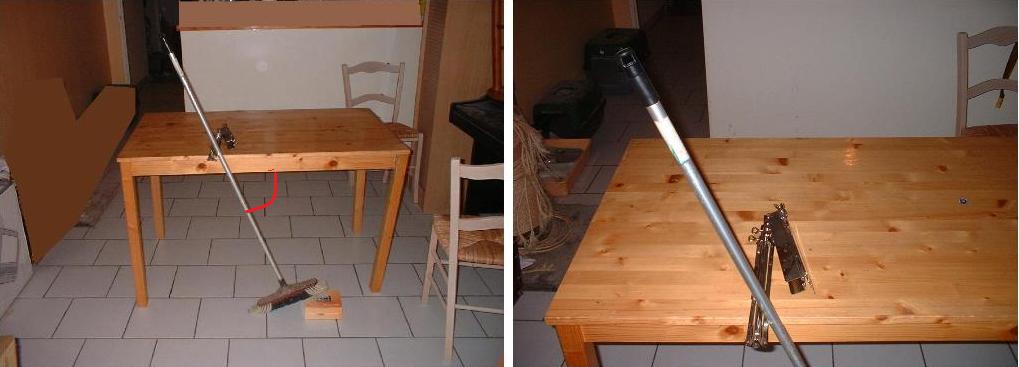 Likewise, if, relatively to the horizontal edge of the table, I orient my broom the same way as the vertical pole of the white device is oriented relatively to the horizon line, and that I move forward between the two photos, the broom shows a counter-clockwise rotation between the two photos. (When I say that I orient my broom the same way, I don't mean that I give it exactly the same angle as the device on the Apollo photo, but that the angle I show is sharp like on the Apollo photo; this detail is important for the direction of the rotation). This comes from the fact that, because the upper part of this one is closer to my eyes than its lower part, when I move forward, the upper part moves faster toward left relatively to a fixed point of the table than its lower part, and this is what makes it turn counter-clockwise. Likewise, on the Apollo photo, when the photographer moves forward, the vertical pole of the device should show a counter-clockwise rotation. To summarize, when the photographer moves forward and on the right, the vertical pole of the device has a double reason to turn counter-clockwise. Yet, the angles between this pole and the horizon line, that I measured on print copies, are 80° for the first photo, and 82° for the second one. The increase of this angle, in the direction I measured it, shows in fact that this pole has in fact turned clockwise, and not counter-clockwise like it should have. It in fact reacted like the photographer had moved on the left instead of the right, and/or backed up instead of moving forward. We have here an incoherence more to add to the list of contradictory rotations, the preferred incoherence of the fakers. |
on the three photos AS11-40-5860, AS11-40-5859, and AS11-40-5861, of which we see here an animation, the astronaut is moving along the LEM. |
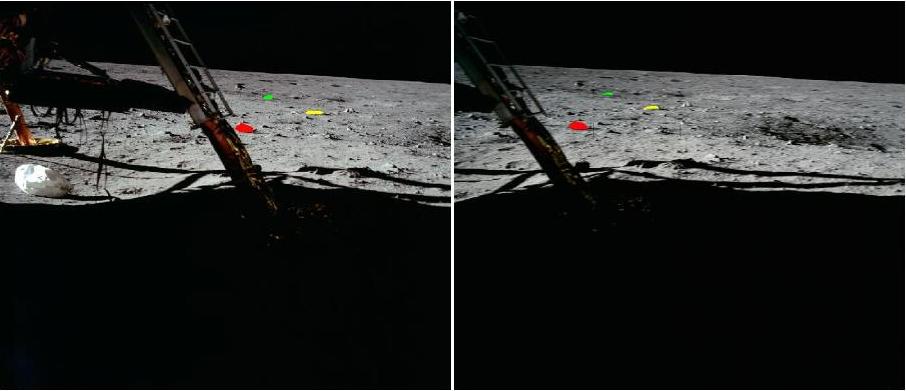 On this double view, we see the first two photos; I have colored with corresponding colors perfectly recognizable artifacts (stones) We can see that because the stones are farther from the photographer than the leg of the LEM, they have moved away from this leg by the fact that the photographer has moved on the right. |
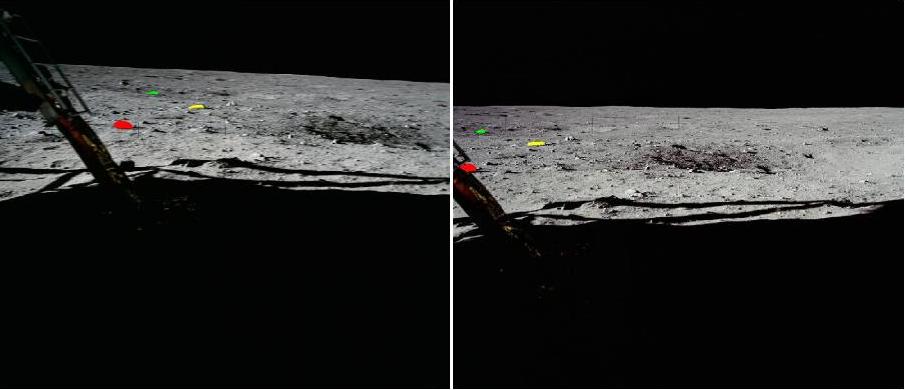 On this double view, the astronaut has still more moved on the right; so we would have expected the stones to have moved still farther away from the leg of the LEM...but it's the converse, they have come closer to the leg, and are even closer to it than they were on the first photo! |
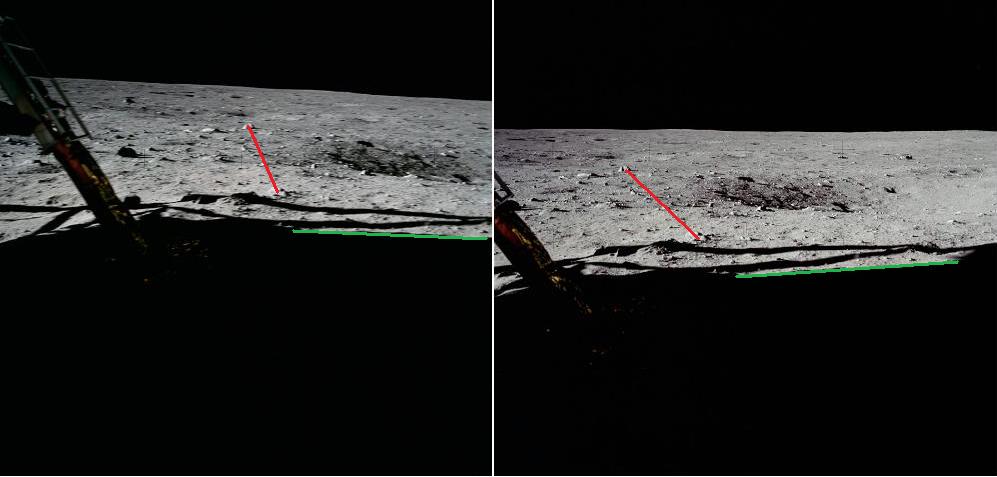 In fact, if we draw a line between a stone in the foreground and a stone in the background, we can see that its direction varies more between the photos AS11-40-5859 and AS11-40-5861 than the direction of the shadow of the LEM. |
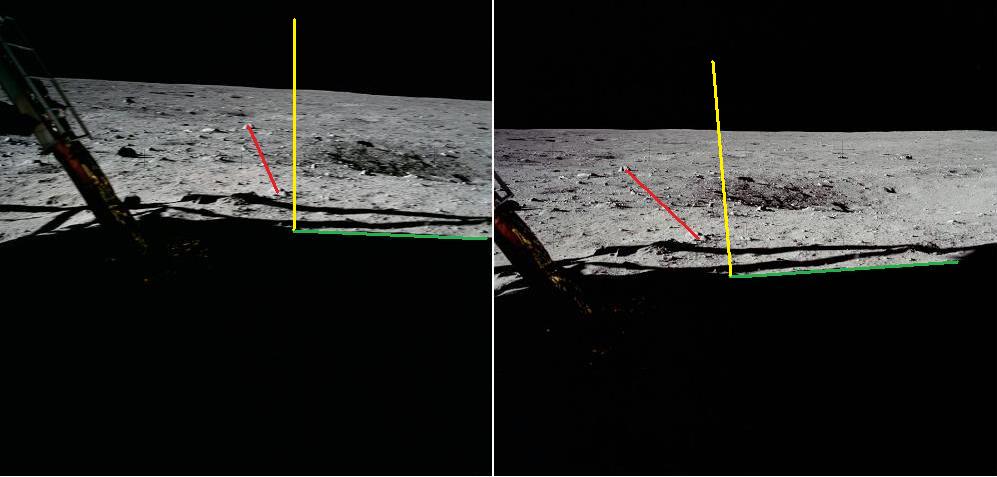 If we draw a (yellow) line in perpendicular to the direction of the shadow and starting from the same location, we can see that it cuts the background differently. The background has moved (on the left) relatively to the foreground. |
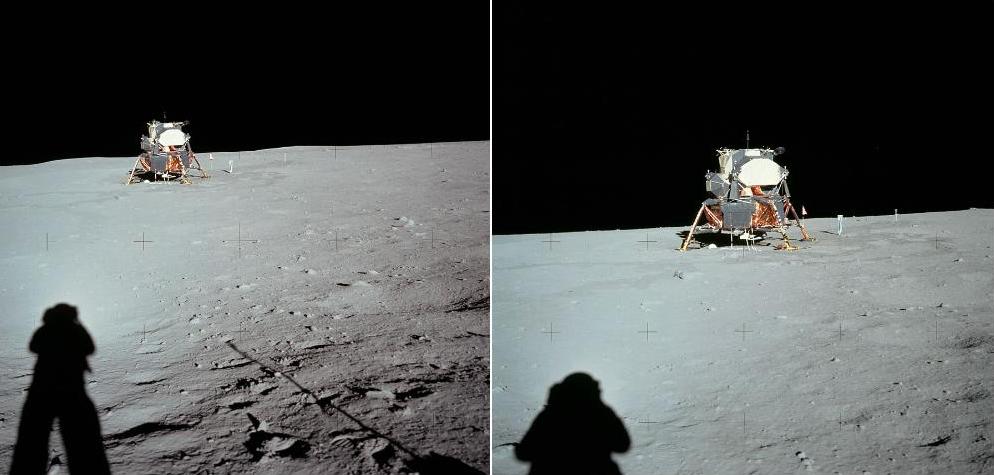 On these two photos (AS11-40-5961 and AS11-40-5962), the photographer takes a first photo of the LEM, then moves forward and takes a second photo. A first remark is that the two horizons are much different: One shows variations, and the other one is entirely flat; yet, the lem shows only a little rotation between the two photos, and therefore the two horizons should normally have a good part in common. The difference of the shadows on the two photos could be explained by the fact that, on the first photo, the photographer was on a descending slope. However there is a difference between the two shadows. Before showing the difference I am going to make a real demonstration.  The photographer's shadow appears on the photo according to the way he orients himself toward the sun. On this photo, I have the sun right in my back; consequently my shadow is on the middle of the photo and seen facing it, not in profile. I have well extended my arms so you can see my orientation. 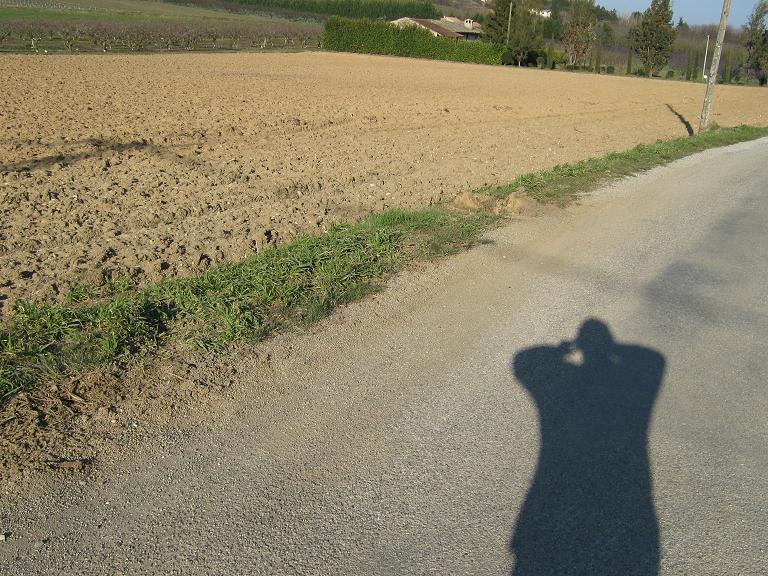 On this second photo, I have pivoted my body on the left (or counterclockwise around the vertical axis, more technically). The sun is now shining on my left; consequently my shadow has been pushed on the right of the photo, and I show a profile oriented on the left.  On this third photo, I have pivoted my body on the right (or clockwise around the vertical axis, more technically). The sun is now shining on my right; consequently my shadow has been pushed on the left of the photo, and I show a profile oriented on the right.  Now look at the profile of the shadow on the two Apollo photos. On both photos, the shadow is pushed on the left. But whereas the profile of the photographer's shadow is oriented toward the right on the first photo, it's oriented toward the left on the second photo. It's on the first photo that the orientation is correct: When the shadow is pushed on the left of the photo, the profile of the photographer's shadow must be oriented toward the right. The orientation of the profile of the photographer's shadow is incorrect on the second photo, and that's the incoherence. 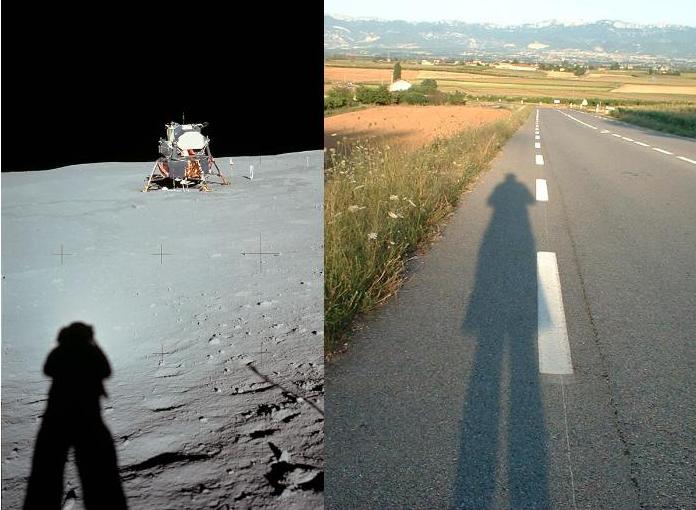 Concerning the first shadow which is seen on a descending slope, there's however a problem: It seems to be linear. I show on the photo of the right how my shadow appears when I take a photo as I am on a descending slope. We can see that the upper part of my body appears shrunk comparatively with the lower part, which is not the case on the apollo photo. |
 On these two photos (AS11-40-5963 and AS11-40-5964), we can see the astronaut getting busy (or pretending to) with the solar wind collector. |
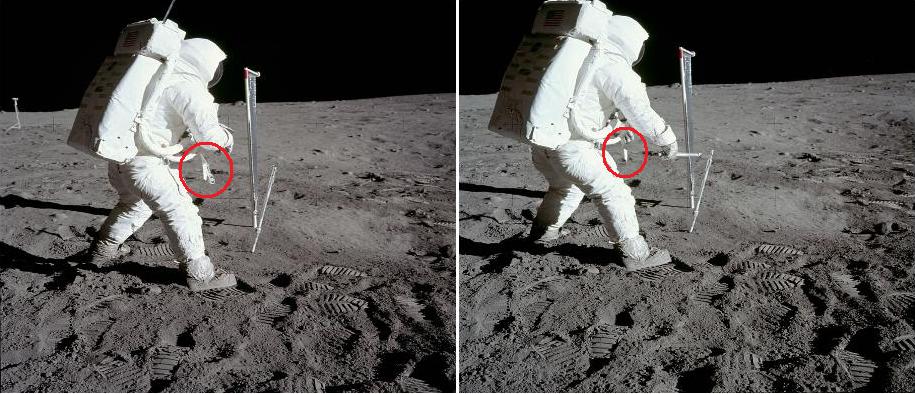 But we can see something which is abnormal, and I have circled it. |
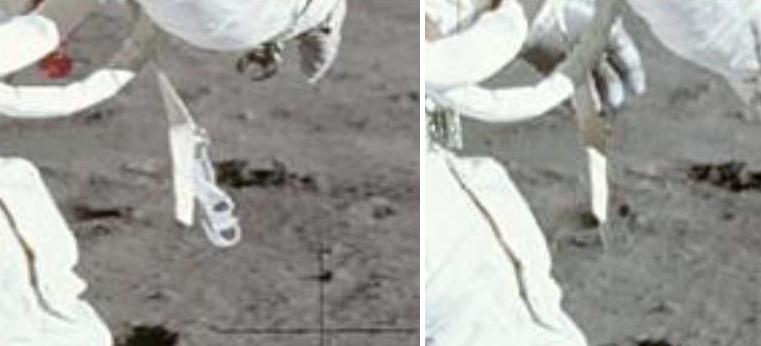 On this close-up, we can see that there are metallic pieces of his harness which have disappeared on the second photo. An Apollo fan has said that these metallic pieces had not disappeared but were just shadowed; in fact, if we look attentively, we can see their contour; but they rather look transparent than shadowed. But the main point is that they have no reason to be shadowed: 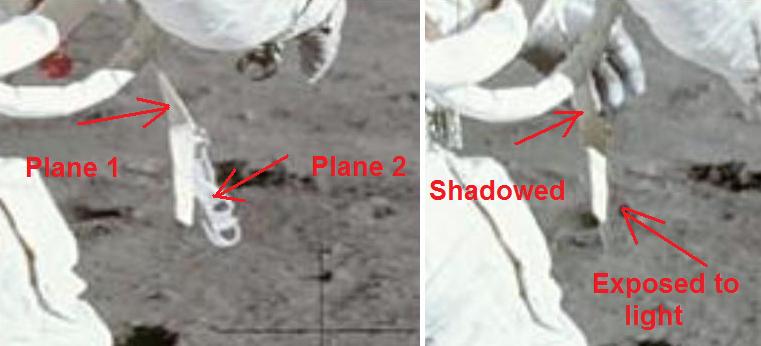 Just next to these metallic pieces, there is a strap. This strap is twisted, and it appears in two bits of different directions which are in two planes which are perpendicular to each other. The lower bit is in a plane which is parallel to the one of the metallic pieces, and the upper one is in a plane which is perpendicular to the latter. On the first photo, the upper bit is shadowed, and the lower one is brightly lit; the metallic pieces which are in the same plane as the lower bit are also lit. On the second photo, the upper bit is still shadowed, and the lower bit is still brightly lit. Thence the metallic pieces are logically still lit and have no reason to be shadowed... ...Unless there would be an object which is placed before these metallic pieces and exactly has the shape of these pieces so that it can shadow these pieces without shadowing at all the strap which is just next to these pieces! |
 On the photo AS11-40-5969, if we look well, we can guess a green face lurking in the shadow of the LEM. I have added more luminosity to this green face to make it more visible. Of course, you could tell that it just happens to look like a green face. But the natural color of the lem is orange, so why does the color appear as green when I add luminosity? And there is something which is still more strange about this photo: We see how the (circled) shadow of the pole is oriented, and thence we can deduce from it the direction of the sunlight. So, why is this side of the lem so much shadowed, when it should logically be rather lit given the direction of the sunlight? |
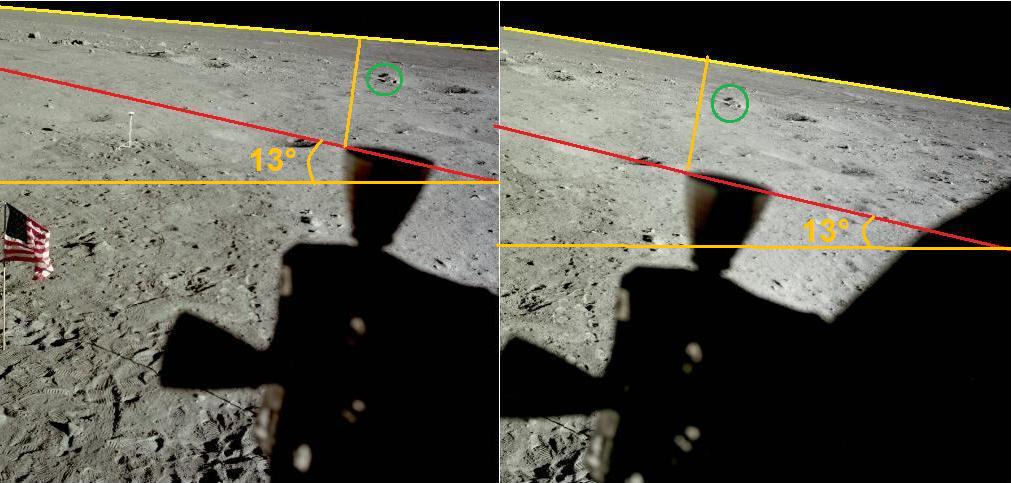 On photos AS11-37-5468 and AS11-37-5469 the photographer takes the photo of the lunar ground from the lem with an lateral thruster in the close foreground. We can see that the position of the lateral thruster relatively to the holes farther away does not change from one photo to the other one; it means the photographer has made no lateral move, he has just turned his camera on the right. So, the direction of the thruster could only change by a rotation of the camera around the horizontal axis (perpendicular to the photo); but we can see that this direction does not change, it makes the same angle with the horizontal of the photo on both photos. The conclusion is that the foreground doesn't rotate around the horizontal axis. Such is not the case for the background: We can see that the horizon line makes a quite important rotation around the horizontal axis from one photo to the other one. This is a first example of foreground and background rotating differently (or background rotating and foreground not rotating, like it is the case here). And this is not the only example, there will be plenty of other ones; this is one of their favorite tricks. On this animation made with the two photos we can clearly see the background rotating and the foreground not rotating. It makes a strange impression. |
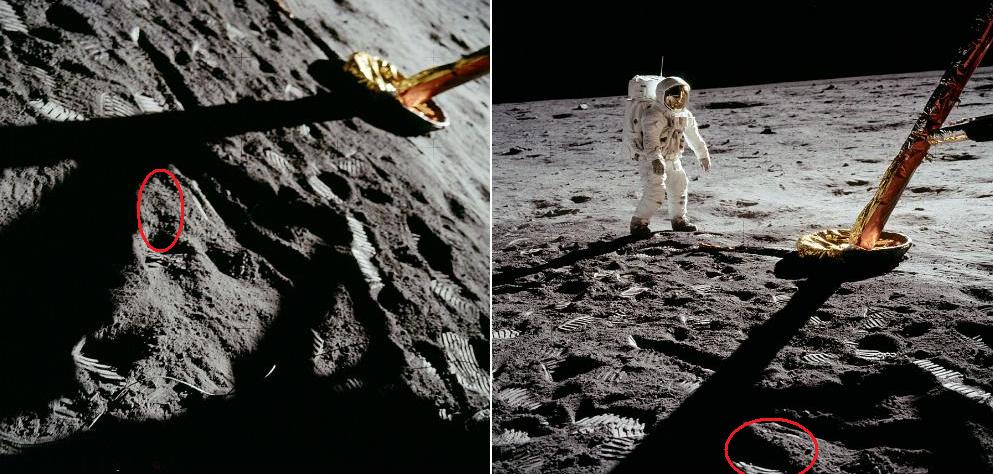 On photo AS11-40-5901 there is an area on the lunar ground (I have circled in red) which is less shaded than it is on the next photo AS11-40-5902. |
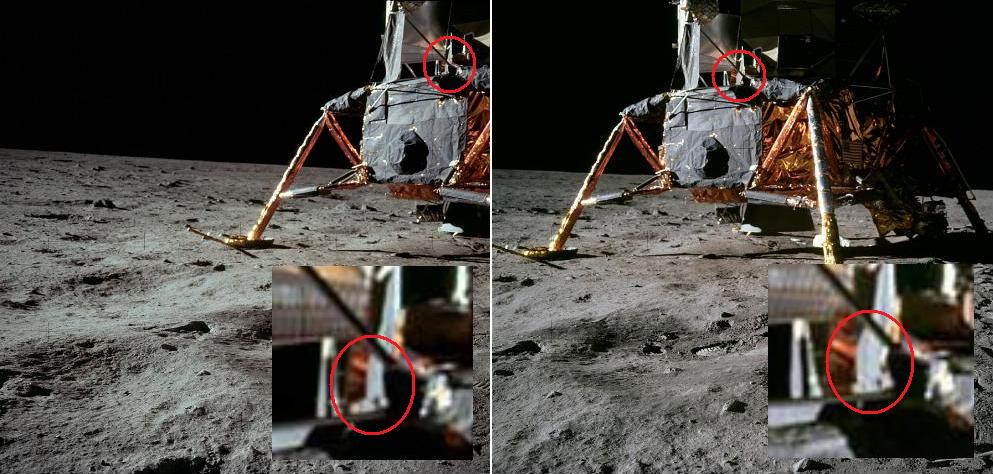 On photos AS11-40-5914 and AS11-40-5015, which present a view of the lem, there is a detail which changes in the zone I have circled in red; I display a close-up of this zone in a window to better show what this detail is. |
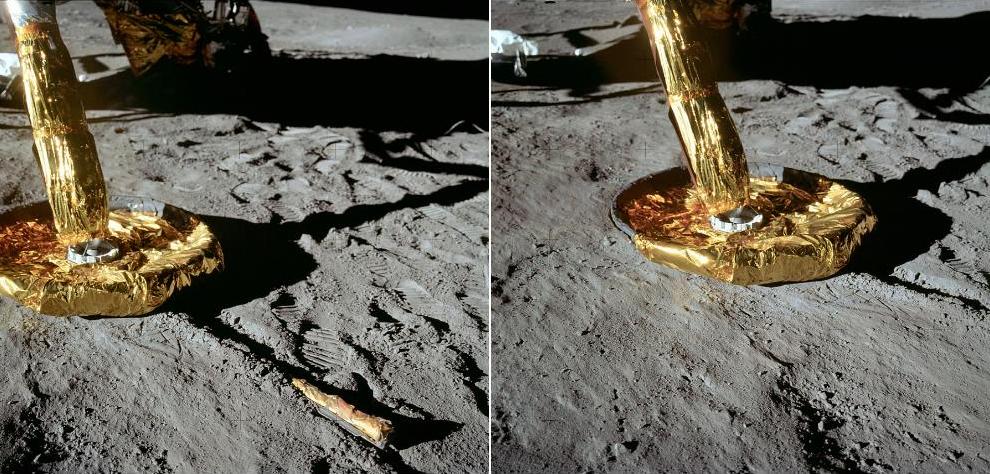 On photos AS11-40-5917 and AS11-5918 the photographer takes a close-up of a foot of the lem. Between the two photos he moves so that the scene rotates; apparently the shadow of the lem's foot does not rotate like the rest of the scene: On the first photo this shadow was more oriented toward the leg's shadow than toward the footpad; on the next photo it's more centered between the leg's shadow and the footpad.  I have corrected the foot's shadow to make it logically rotate like it should have. I'm not sure it's absolutely correct, but it's more plausible than the original picture; at least here we can see the foot's shadow rotate with the rest of the scene. Here is an animation with the two original photos; we can see the scene rotating and the foot's shadow not rotating. And here is an animation with the first photo and the modified second photo: This time we can see the foot's shadow rotate with the rest of the scene. |
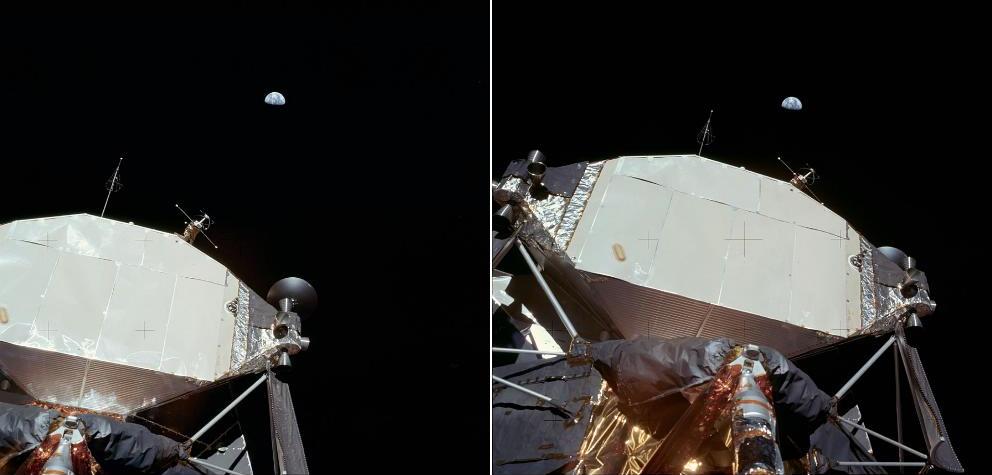 On these two photos (AS11-40-5923 and AS11-40-5924), The astronaut has taken three actions to confuse people: 1) He has cocked his camera, so that the lem is seen obliquely; the horizontal of the photo is not the real horizontal, the real horizontal is parallel to the lower (or upper) edge of the lem, and the real vertical perpendicular to the latter. 2) On the first photo, he has the lem on his left, and on the second photo, he has moved on the left and he is now facing it. 3) And finally, on the second photo he has turned his camera toward the ground, so that the lem moves up on the photo, but every other object as well (including the earth). 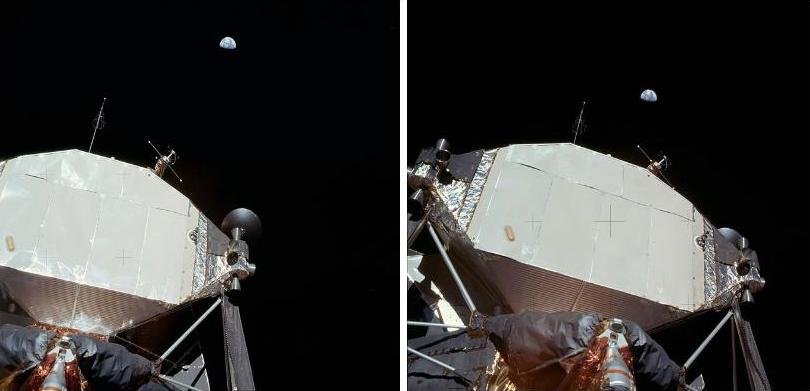 First I cut two equivalent windows from the photos to eliminate the effect of the move of the camera toward the ground on the second photo. We can see that the earth moves both horizontally and vertically relatively to the lem. We can also see that the distance between the objects on the lem has a little increased on the second photo, but is it an excuse for the earth going down relatively to the lem? 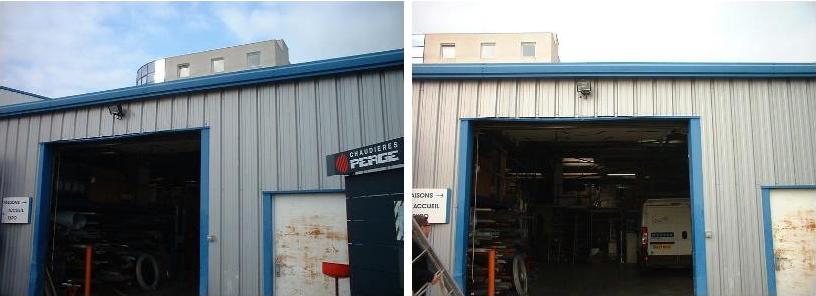 In order to give explanations, I have figured it was better to show them on real examples. Here I am before a garage, and behind this garage we can see a taller building of which we can see the top. On the first photo, I have the garage on my left, and on the second photo I have moved on the left, and I face this garage; but I have tried to remain at the same distance from the garage's wall. 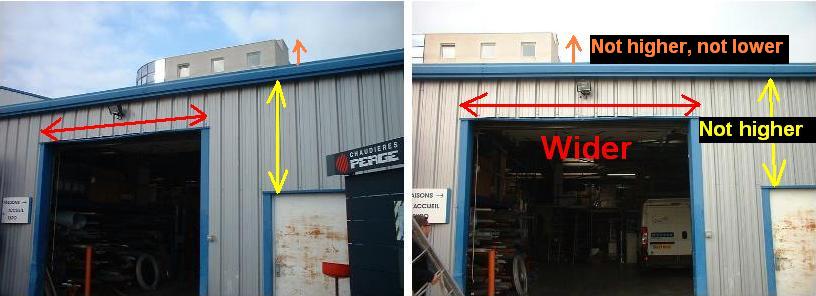 What can we see? That, on the second photo, the garage's door appears wider by the fact that I have moved laterally, but not higher. The building which is behind the garage shows the same part: It's neither higher nor lower. 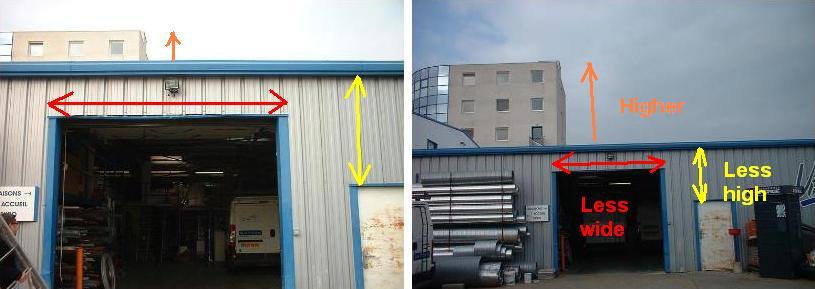 Now, I do back up. The result is that the garage's door is less wide, but also less high this time. And now the building which is behind the garage has come up relatively to this one; we see a more important part of it.  So, if effectively the photographer has come closer to the Lem, the height of the white panel of the lem must be different on the two photos: It should be greater on the second photo. But it's not the case, the height is exactly the same on the two photos; therefore, the photographer has not come closer to the lem, he has only moved laterally, and this is what has caused the lateral distance between the objects to increase. 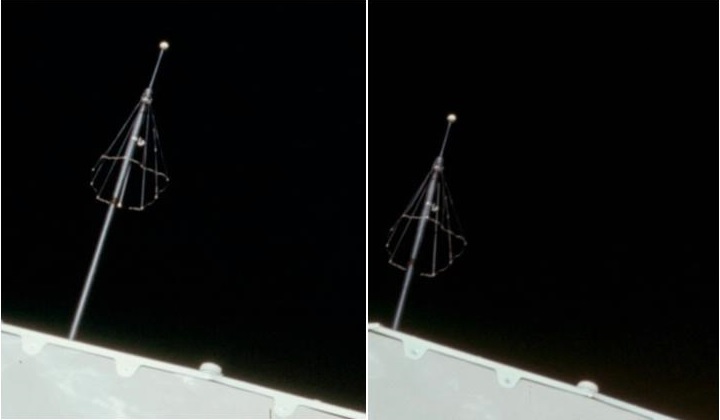 Now, someone has pointed out that there was a vertical pole on the top of the LM which had not just moved laterally relatively to the LM's edge, but that it was also appearing lower, which would be an indication that the photographer has moved forward. But it is a trick in fact, if the photographer had moved forward, the panel's height would have increased, which it has not. If this pole appears lower on the second photo, it is simply because they have pulled it down. You'll tell me I have no proof they touched it? Oh yes, I do have a proof they touched it, and I am going to show it to you. 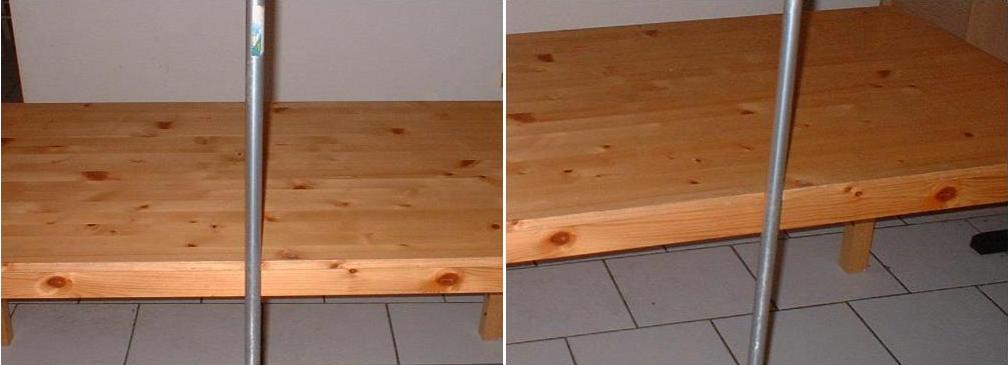 In this demonstration, I put a broom vertically against a table, and I take a first photo (photo of the left) when I am in front of it; then I move on the left and I take a new photo (photo of the right); and what can we see? We can see that the broom shows a clockwise rotation due to the fact that I moved on the left; this clockwise rotation is easy to explain: It comes from the fact that, as the top of the broom is farther from my camera than its bottom, it moves more away from my camera than its bottom as I move on the left, and this is what creates the clockwise rotation. 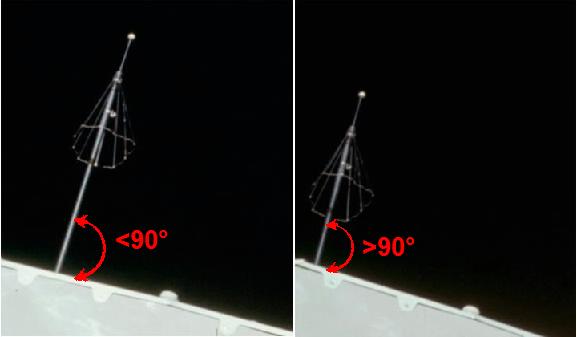 As the photographer has moved on the left between the two photos, the vertical pole should show a slight clockwise rotation between the two photos...But it is not the case: On the first photo, the pole makes a little less than a right angle with the LM's edge (on the right), and it makes a little more than a right angle with the LM's edge on the second photo; it has not turned clockwise like it should have, but counter-clockwise instead, which is impossible if they haven't touched it. Therefore, they have necessarily touched it between the two photos; but they didn't just slightly rotate it, they also pulled it down to give the illusion the photographer had moved forward; pulling it down is intended to lure bad observers, and rotating it is intended to give to good observers the confirmation that they touched it. 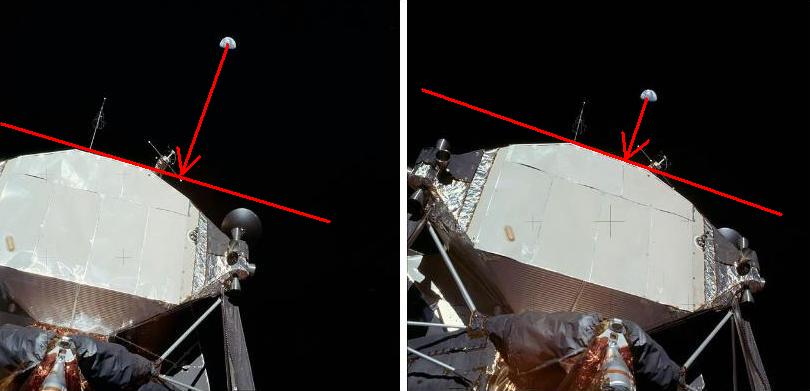 So, if it is normal for the earth to move horizontally relatively to the lem (and when I say horizontally, I mean the real horizontal, not the one of the photo), on the other hand it should not move vertically, and yet it does! 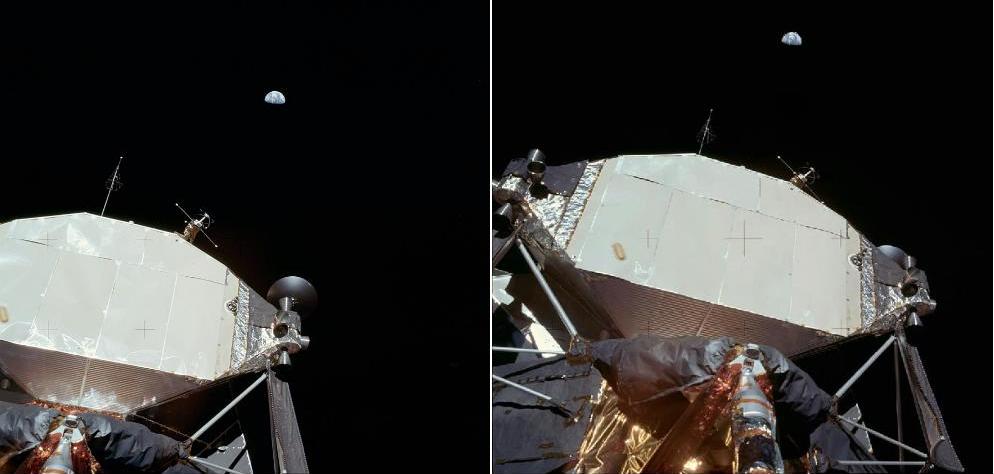 I have corrected the second photo to make the earth look like it should have: I have left the earth at its new horizontal position relatively to the lem, but put back the earth at the same vertical position it had relatively to the lem on the first photo. Here is an animation made with the two original photos, with the vertical position of the earth relatively to the lem varying. And here is an animation made with the first photo and the second modified photo, with the vertical position of the earth relatively to the lem not varying. |
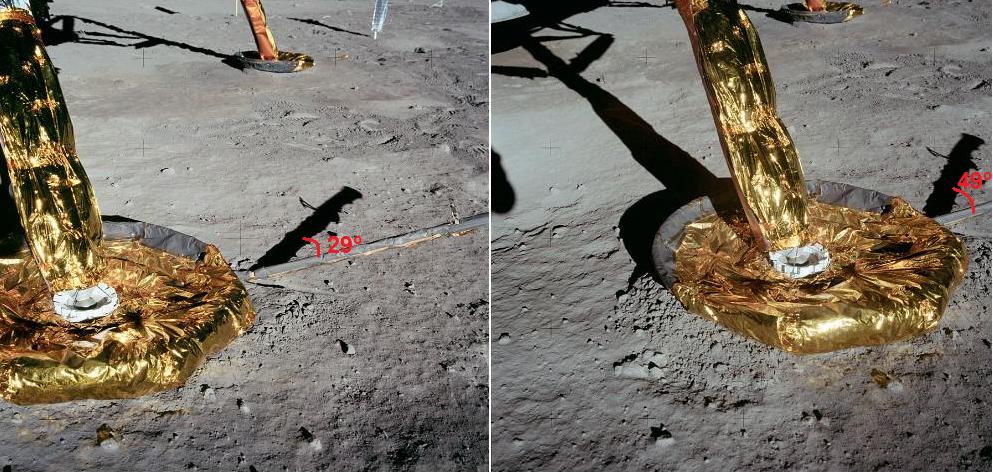 Photos AS11-40-5895 and AS11-40-5896 are two close-ups of a lem's foot with the footpad. The angle that the footpad makes with its shadow is very different from one photo to the other one, though the perspective is not very different. Besides I am going to show you a little real demonstration which will prove you that there is no reason that the angle between the footpad and its shadow should change so much between the two photos. We can see how the photographer moved: We can see that he backed up a little, but that he also moved on the left, and this is obvious because the foot which is close shifted on the right relatively to a foot which is farther away. I have created an angle between a broom and my musical holder, and I took two photos of the whole; one close, and one after backing up and moving on the left.   On the second photo, not only the angle between the broom and the musical holder has not increased, but it has even slightly decreased. |
 On photo AS11-40-5896, the shadow of the vertical stick dug into the ground is almost as long as the distance between the leg and the shadow of the transversal bar of the leg, and yet this stick is much smaller than the height of this transversal bar. |
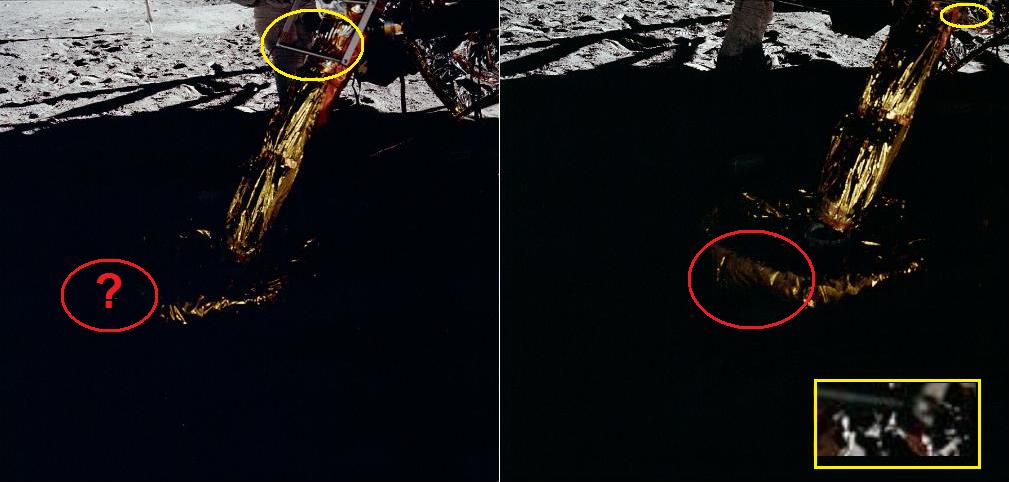 On photos AS11-40-5895 and AS11-40-5896 we have two views of a lem's foot in the shadow of the lem. The perspective of these two views is quite close: We can indeed see a bit of the ladder I have zoomed on the second view. There is a part of the foot (I have circled in red) on the first view which is dark whereas this same part is much brighter on the second view. Why? The lunar "reflectivity" is the same on the two views, it can't brutally change! |
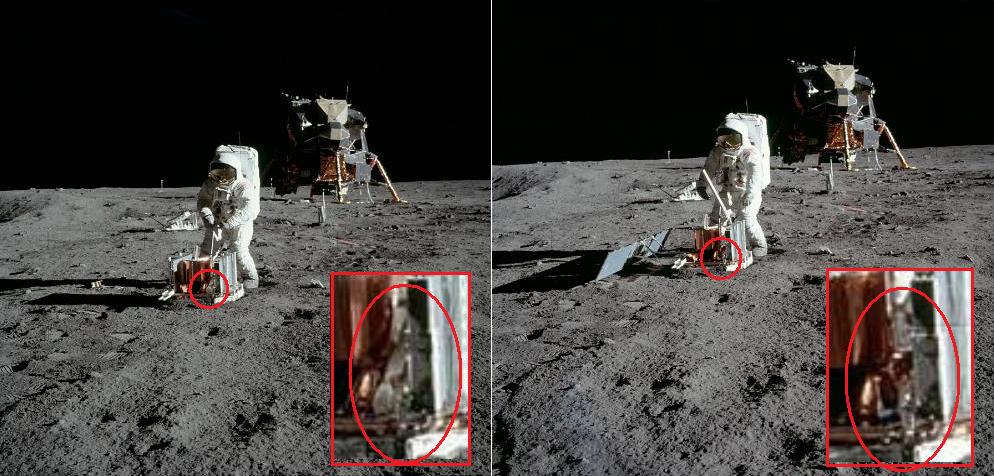 On photos AS11-40-5946 and AS11-40-5947 the astronaut is getting busy with the seismometer. On the zone I have circled in red, and of which I show a close-up in a window, we can see a funny cartoon's character appear on each photo. You could always say that it's my imagination and that it just happens to look like a cartoon's character, but at least it should be the same on the two photos, and it is not! |
 On photos AS11-40-5949 and AS11-40-5950, we can see a weird rock I have circled. 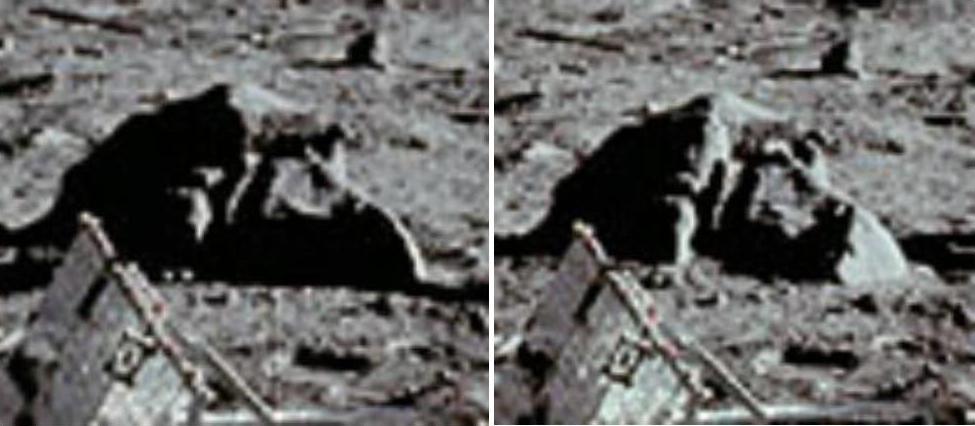 If we make a close-up on these rocks, they appear different. |
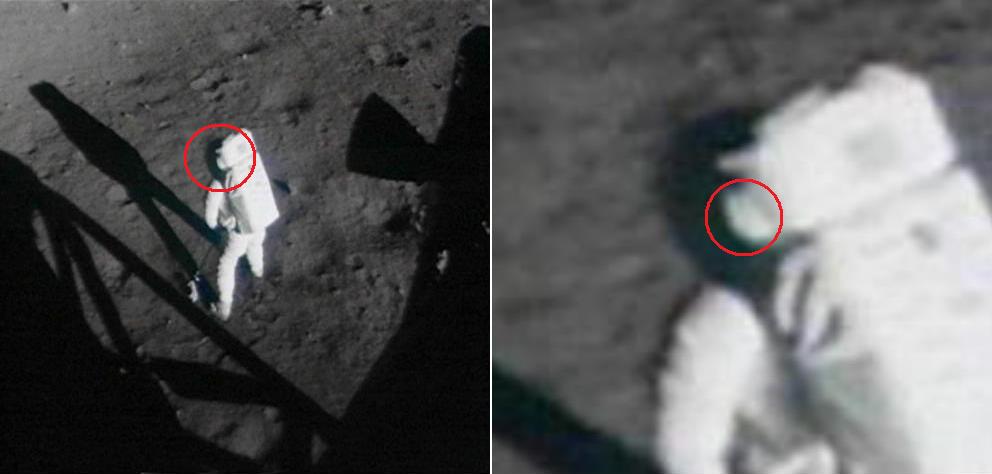 On this photo (Ap11fr01), the helmet (circled in red on the left photo) is blackened for apparently being in the shadow. But on the close-up (on the right) we can see that there is an area on the helmet (circled in red) which is white, so not shadowed; in this case why is the rest of the helmet shadowed? The top of the bag and the astronaut's shoulders are brightly lit; the only thing which could partially shadow the helmet is the top of the bag. But we could expect the shadowed part of the helmet to be close to the bag, especially in reason of the sphericity of the helmet, and it's the converse! |
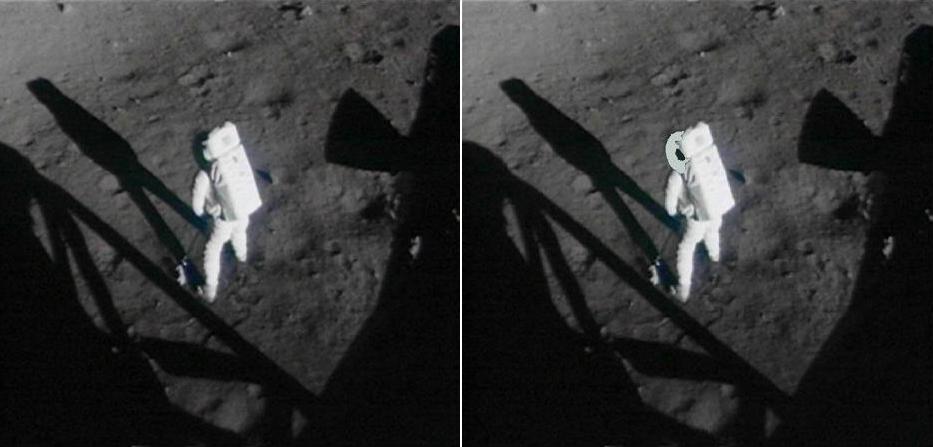 On the photo of the right, I have inverted the shadowed part of the helmet and the not shadowed part, and it looks more logical this way. |
 On these two first photos (Ap11fr01 and Ap11fr02), we can see first Buzz bent; so he is smaller than when he is standing upright, and so should be his shadow; on the next photo, Buzz is standing upright, so is certainly taller than he was on the previous photo; we could expect his shadow on the second photo to be taller than on the first photo, the perspective and relief being the same. But it's the converse, the shadow is taller on the first photo. Note: On the second photo, the shadow starts from the foot which is closer to it, not the foot which is farther! |
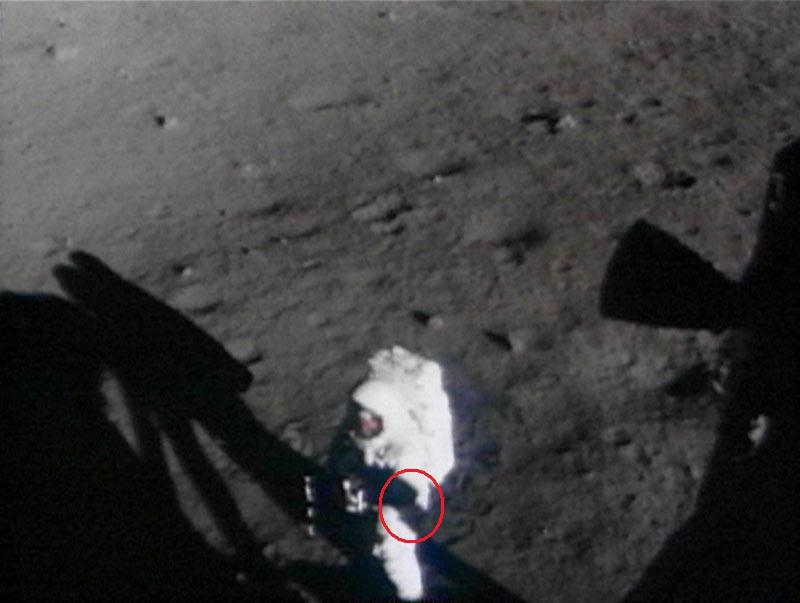 On the photo Ap11fr04, the shadow of the LEM's leg crosses the astronaut. At the place I have circled, the shadow of the leg is deviated by the arm of the astronaut. But from this point, the shadow shows an abnormal discontinuity. There is first a change of color, the shadow switches from grey to black; yet it's still on the same astronaut's suit. Then there is the important change of width of the shadow, just as unexplainable; the arm is slightly closer to the camera, but not enough to create a so important change of width of the shadow. |
 On the photo Ap11fr06 (photo of the left), the photographer lowers his arm, and his arm then only produces a reduced shadow on his suit, and of grey color. On the photo Ap11fr07 (photo of the right), the photographer raises his arm, and this time his arm produces a much wider shadow, not only covering his helmet, but even a part of his bust, and of black color. It must be a variable shadow arm! |
With the animation, it gives a comical effect. |
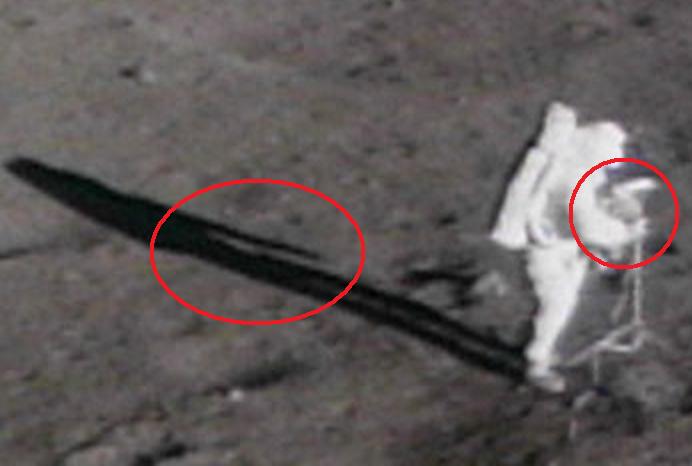 On the photo AP11fr08, the shadow does not correspond with the astronaut and his camera. It appears like the astronaut was just letting his arm along his body. |
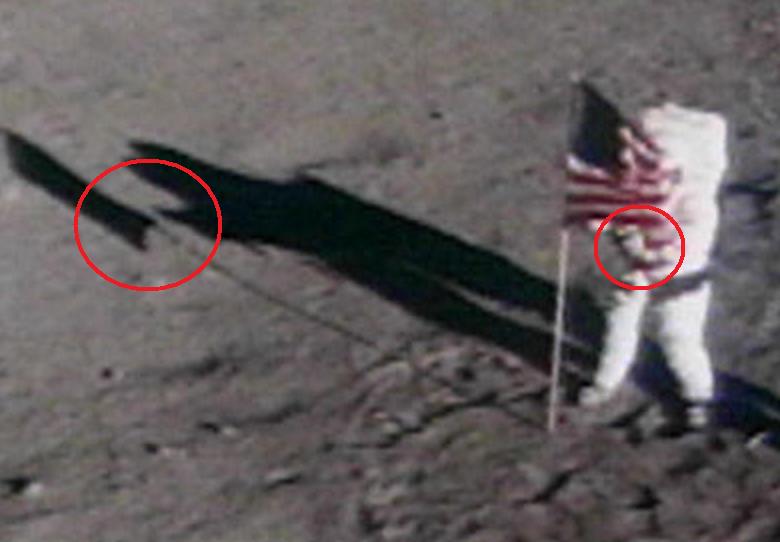 On the photo AP11fr10, the astronaut is touching the flag with his hand, but on the shadow he is not. |
 Between the photos AP11fr10 and AP11fr11, Armstrong has backed up to take a photo; normally he should only have disturbed the ground on his path, but we can see that the ground is disturbed much beyond his normal path. In case you would not well see on the still picture, this animation might allow you to better visualize how the ground has been disturbed when Armstrong has backed up, much more than it should normally have been. |
 Here we have both the aerial view (Ap11Fr11), and the photo taken by Armstrong (AS11-40-5874) which corresponds. We can see that: 1) The shadow of the LEM is different on the two photos. 2) The flag is different on the two photos. 3) Armstrong should be more on the left on the aerial photo: on it he is facing a big hole which is at the extreme left on the photo he took; I show this hole with a red arrow on both photos; and on the aerial photo, I show, with a yellow arrow, how Armstrong should be placed to take the photo we see on the level of the ground. |
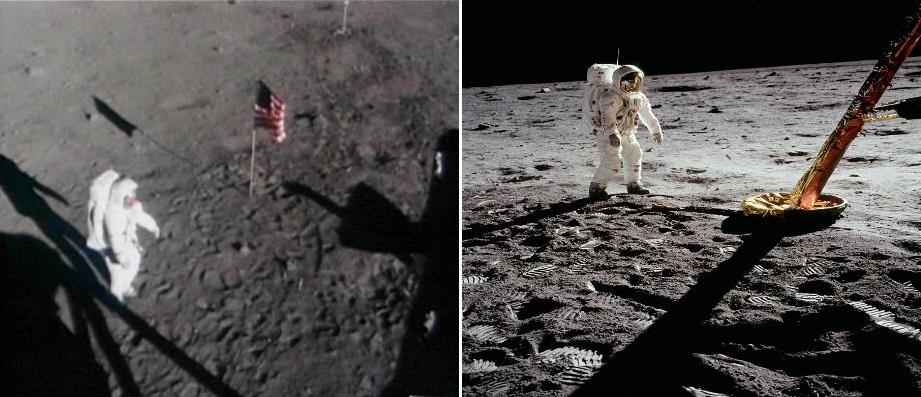 Here we have the aerial view (Ap11fr12) and the only photo taken by Armstrong which can correspond (AS11-40-5902). Indeed, Armstrong has moved on the right along the LEM down and has passed the lower edge of the photo, out of the field of the aerial camera. |
This can be seen by the footprints he left on this animation. Before disappearing from the field of the camera of the top of the LEM, he has stopped to face buzz and took a frontal photo of him. |